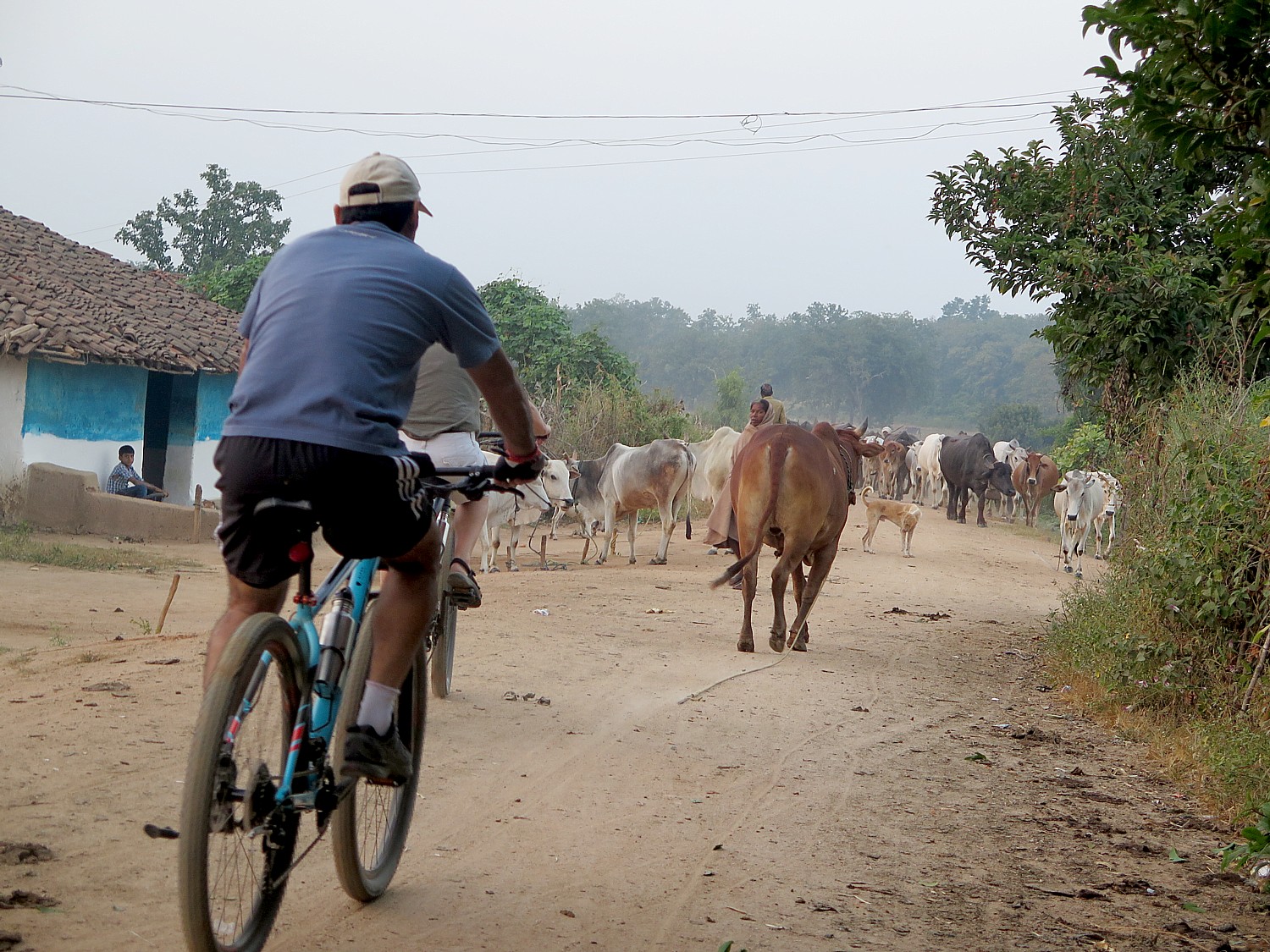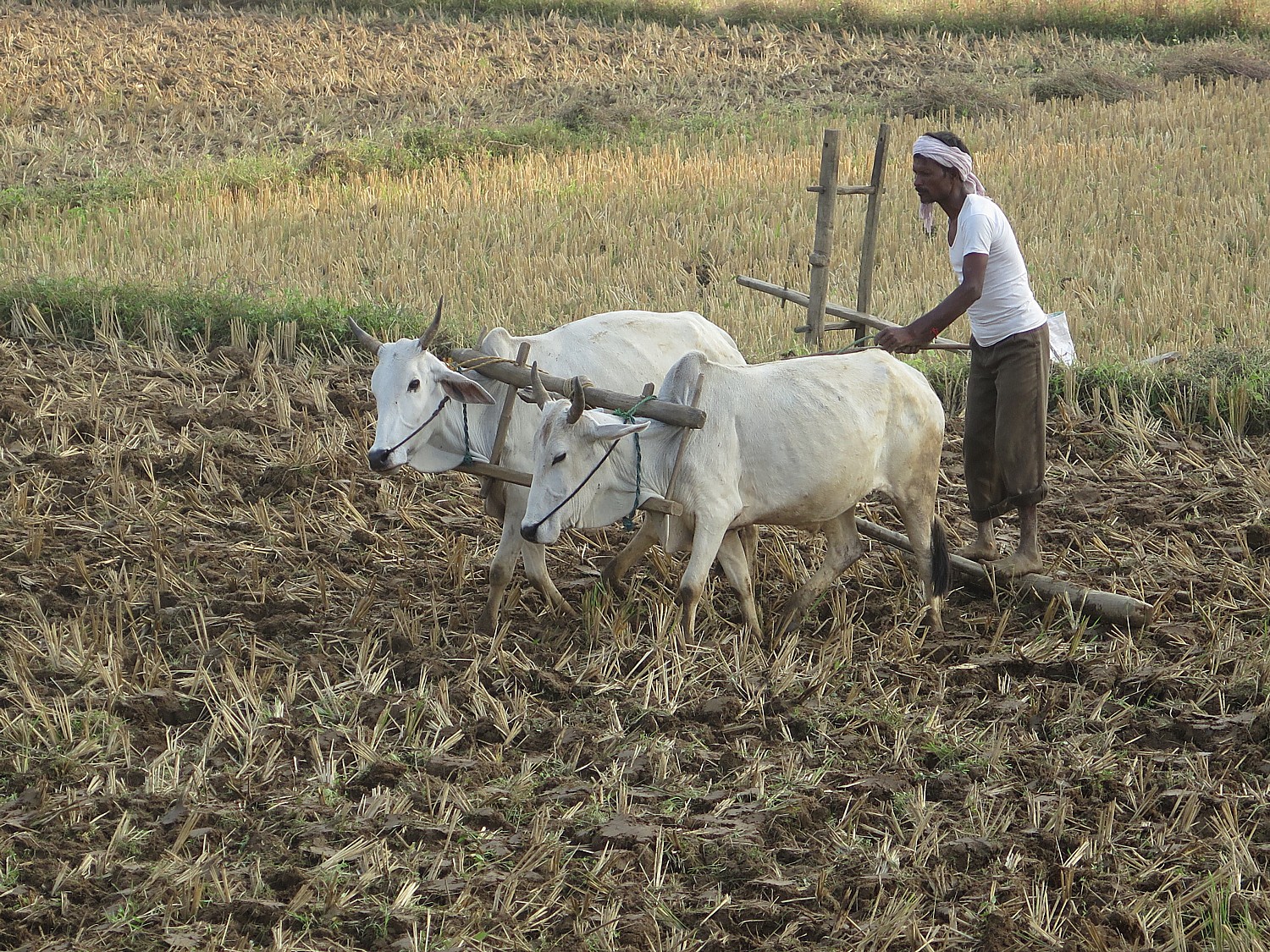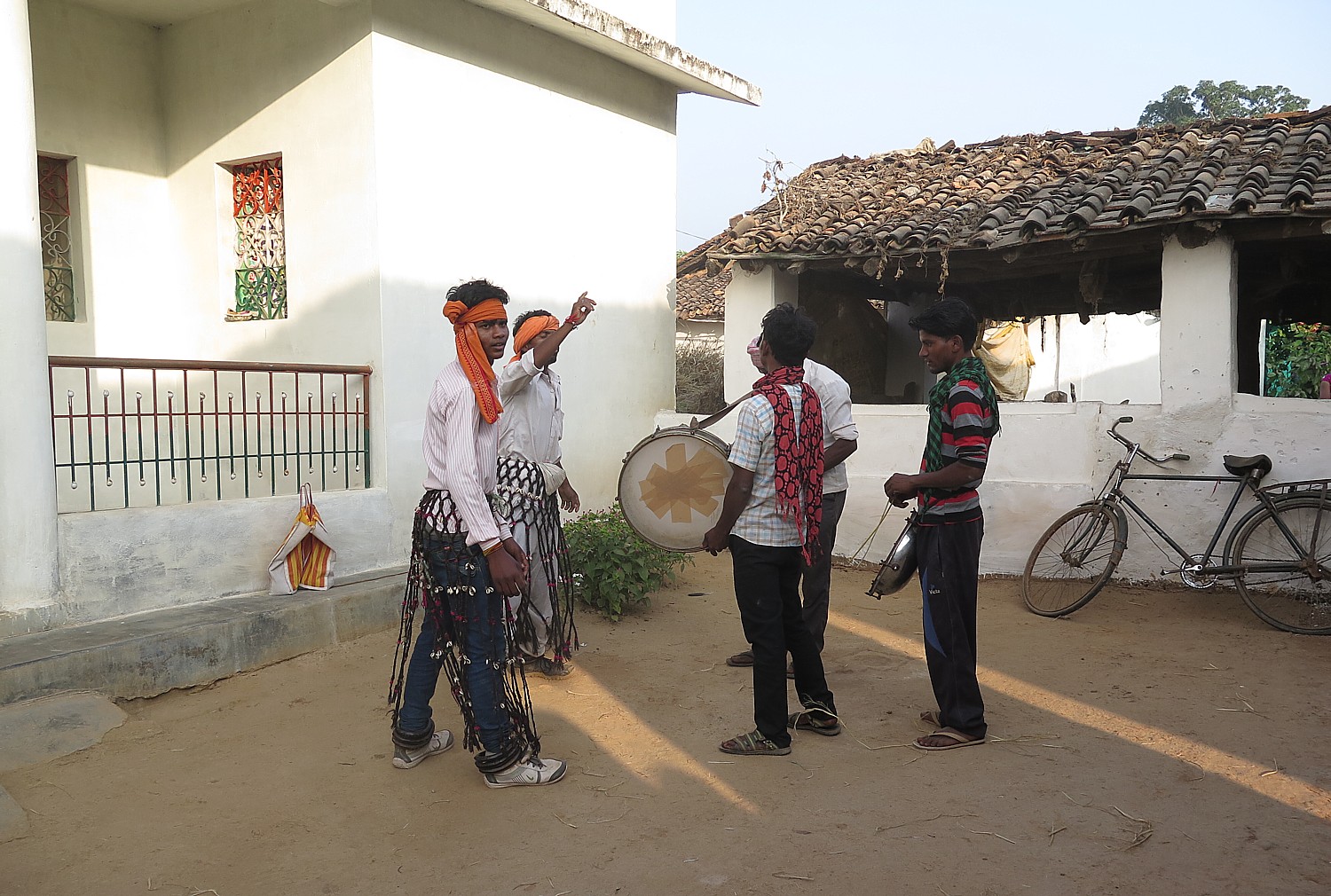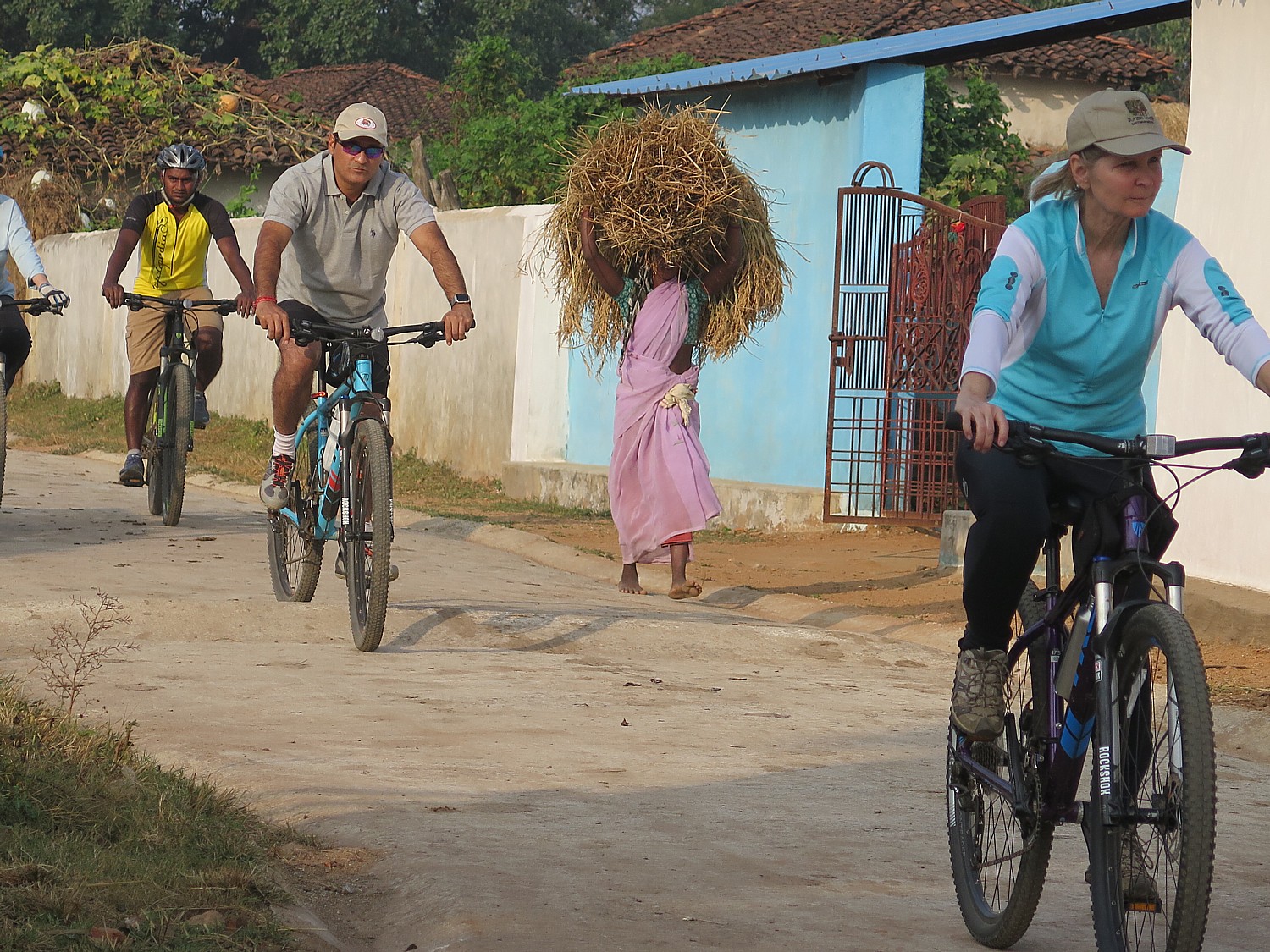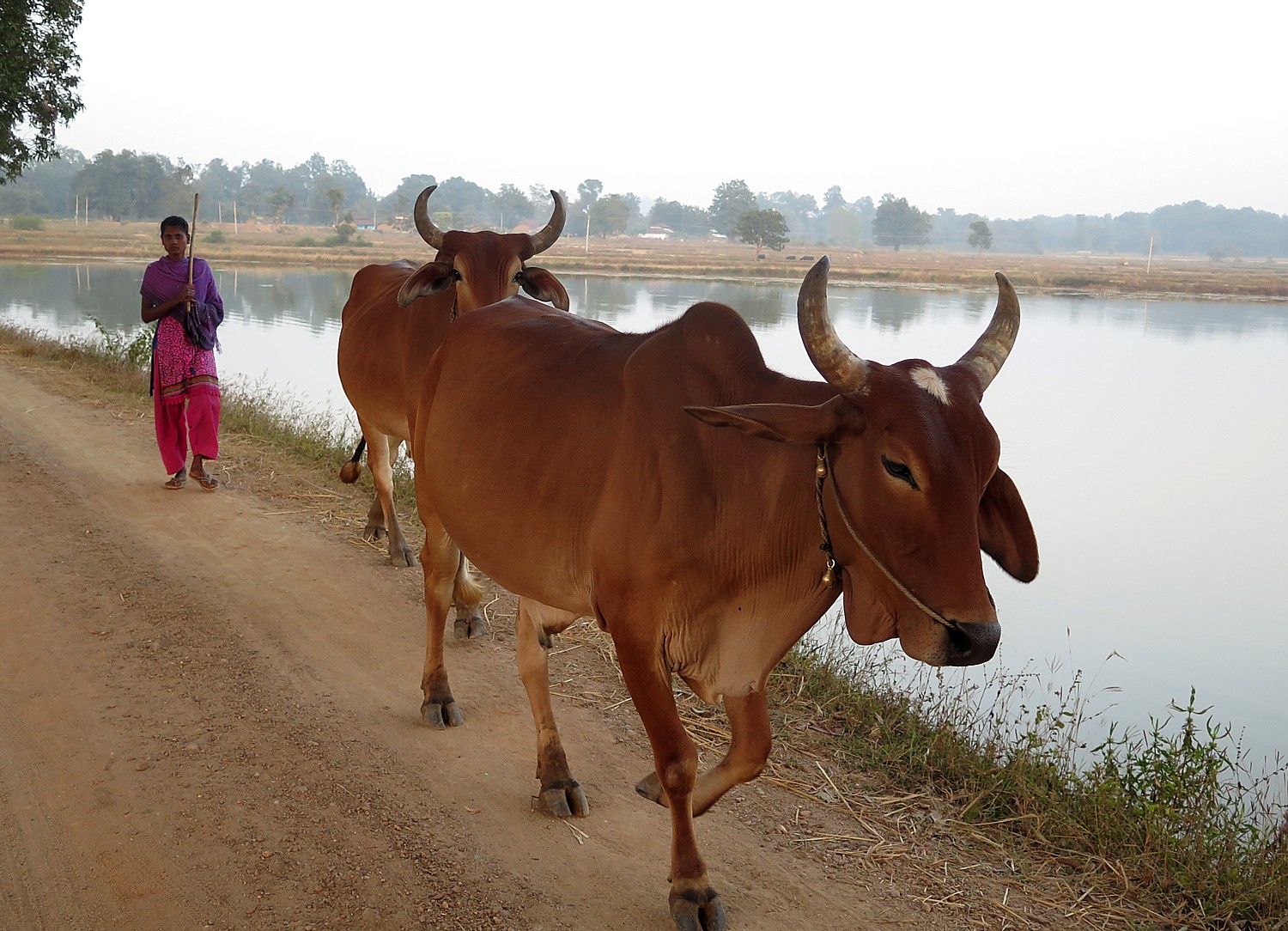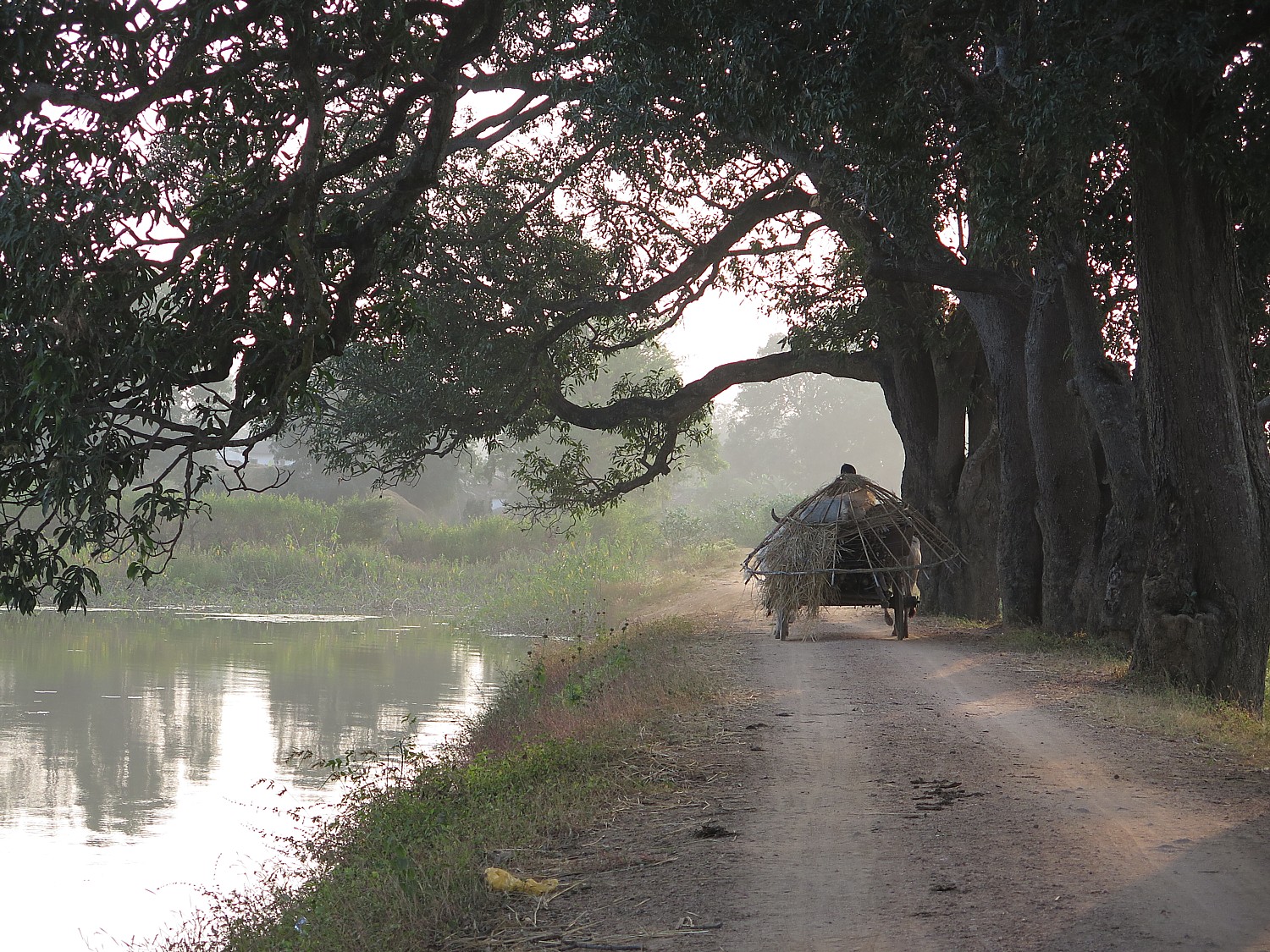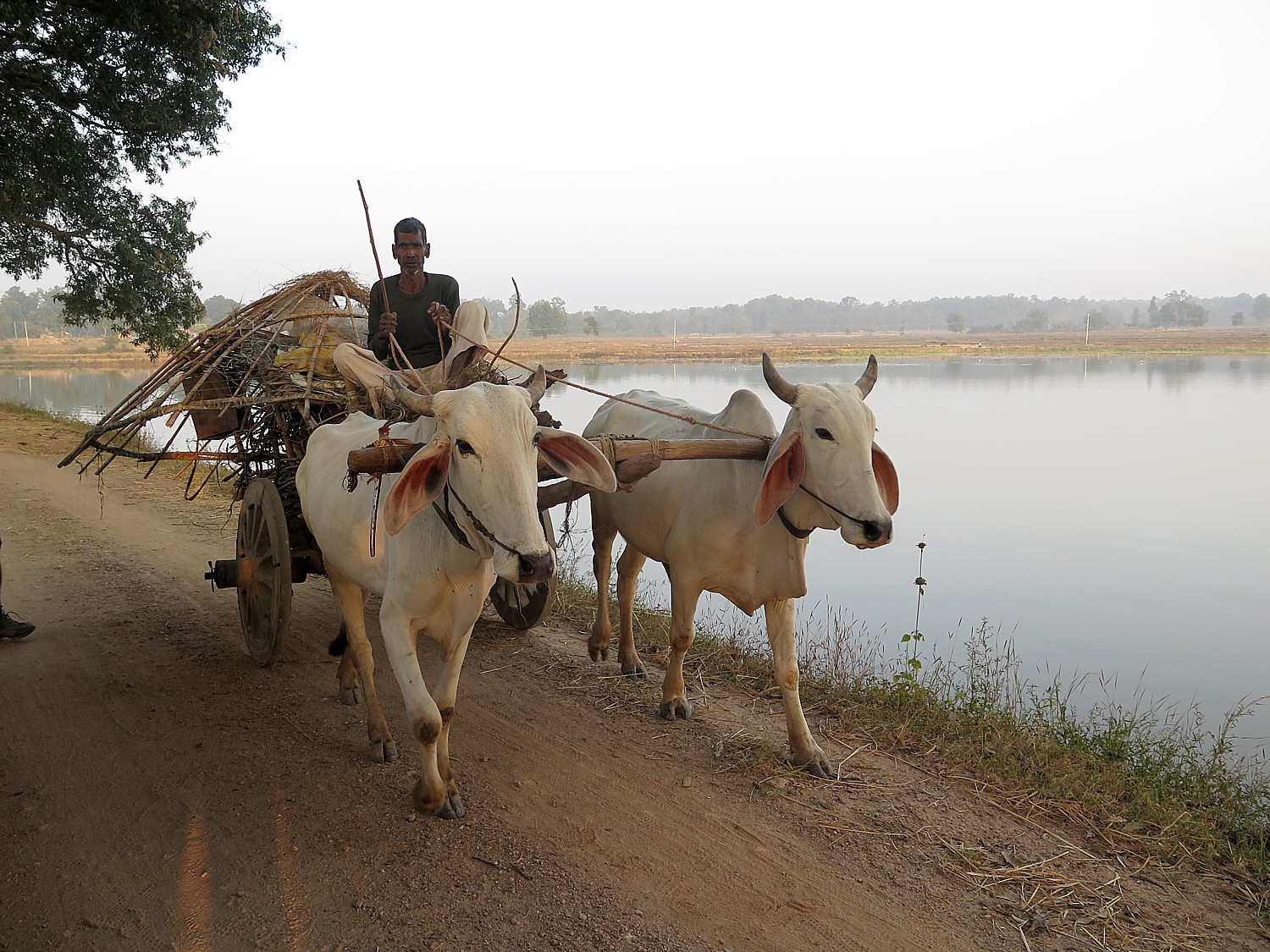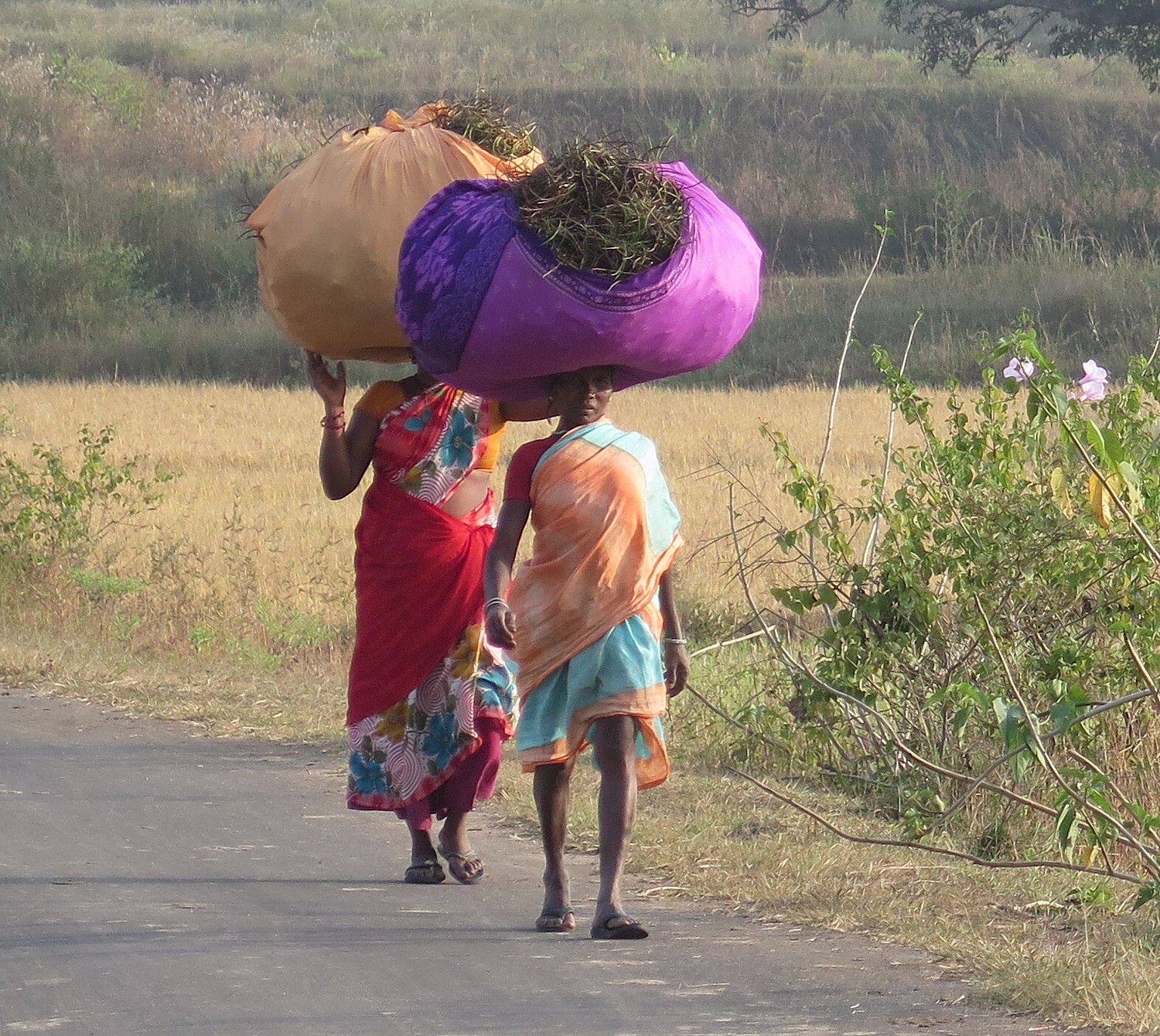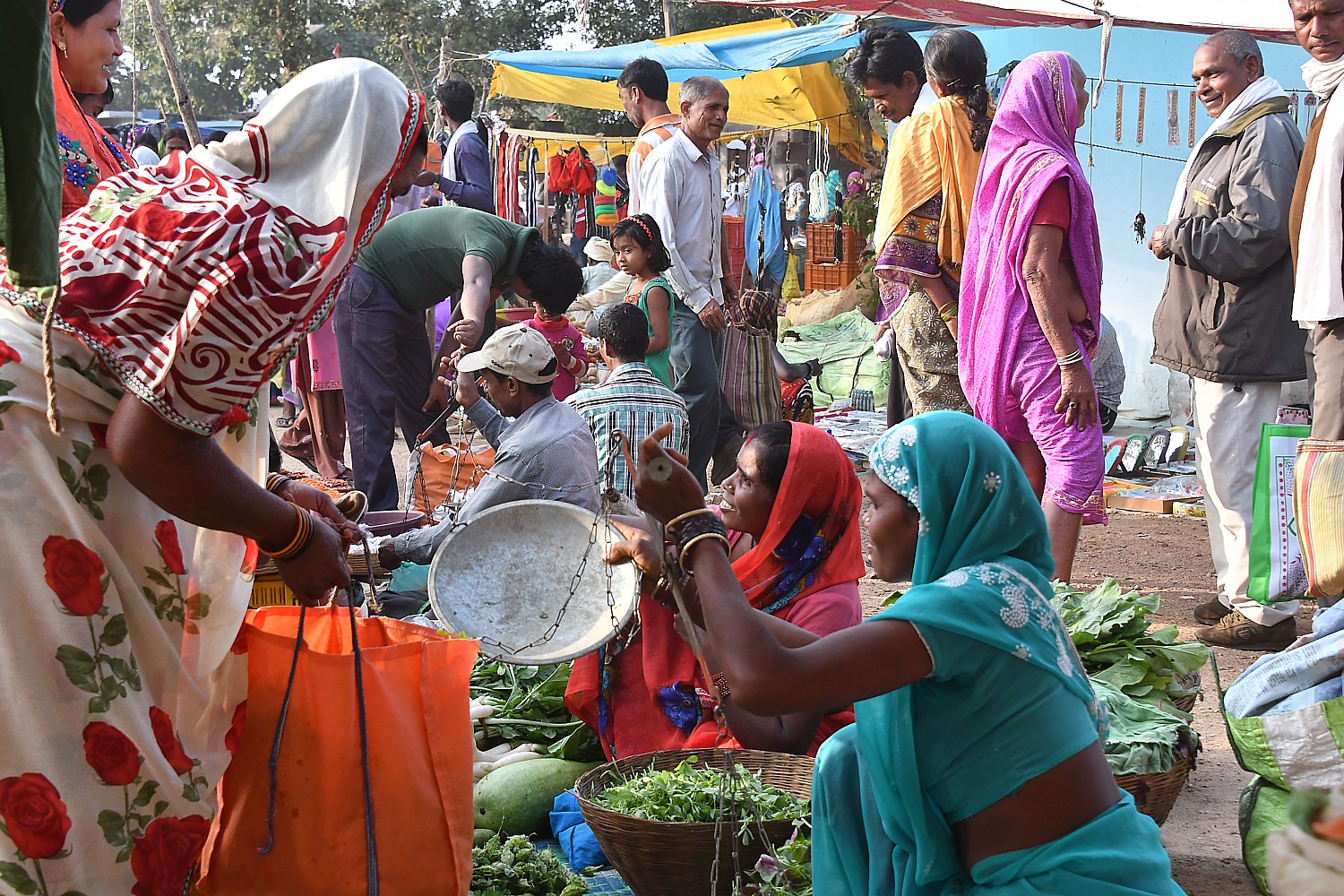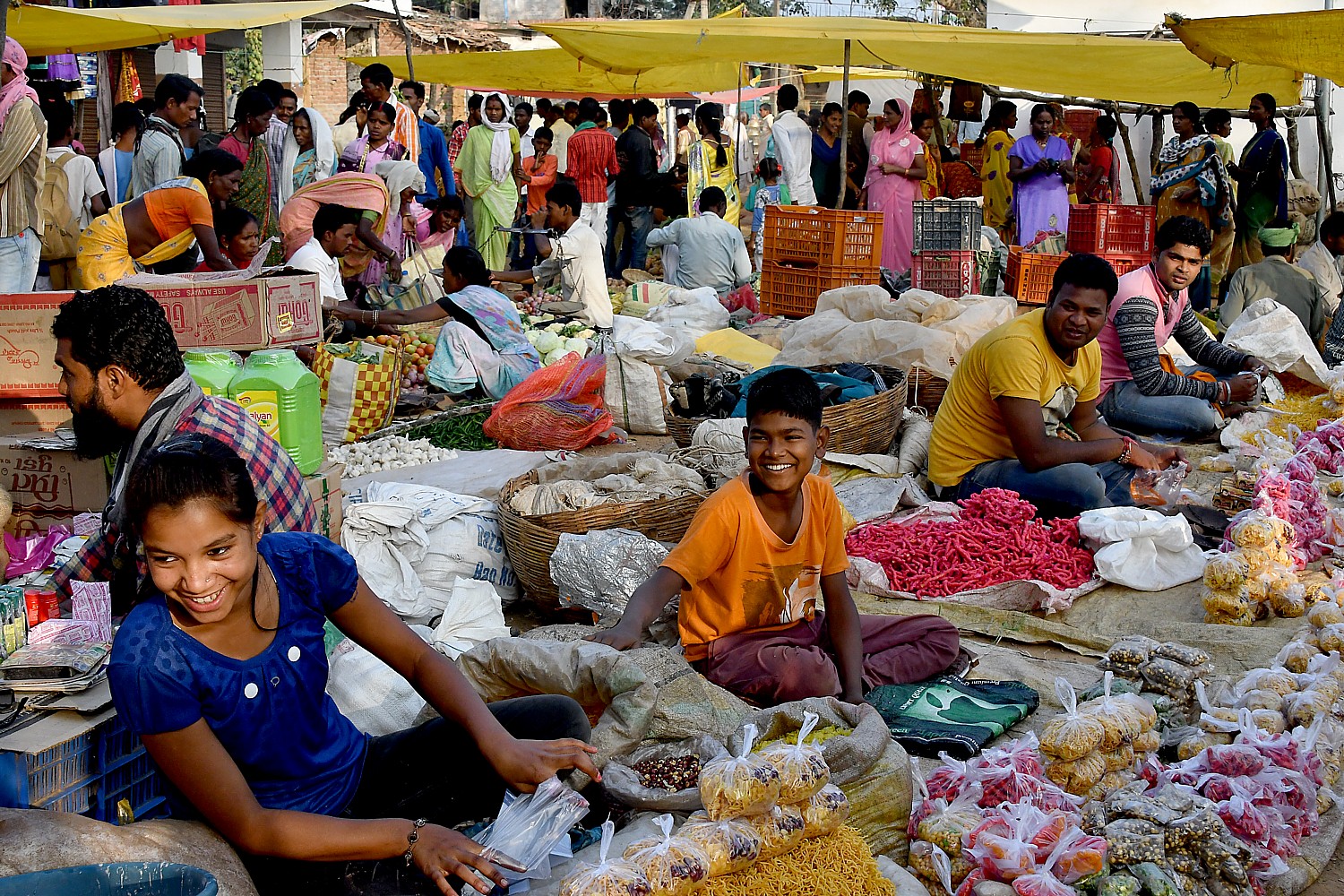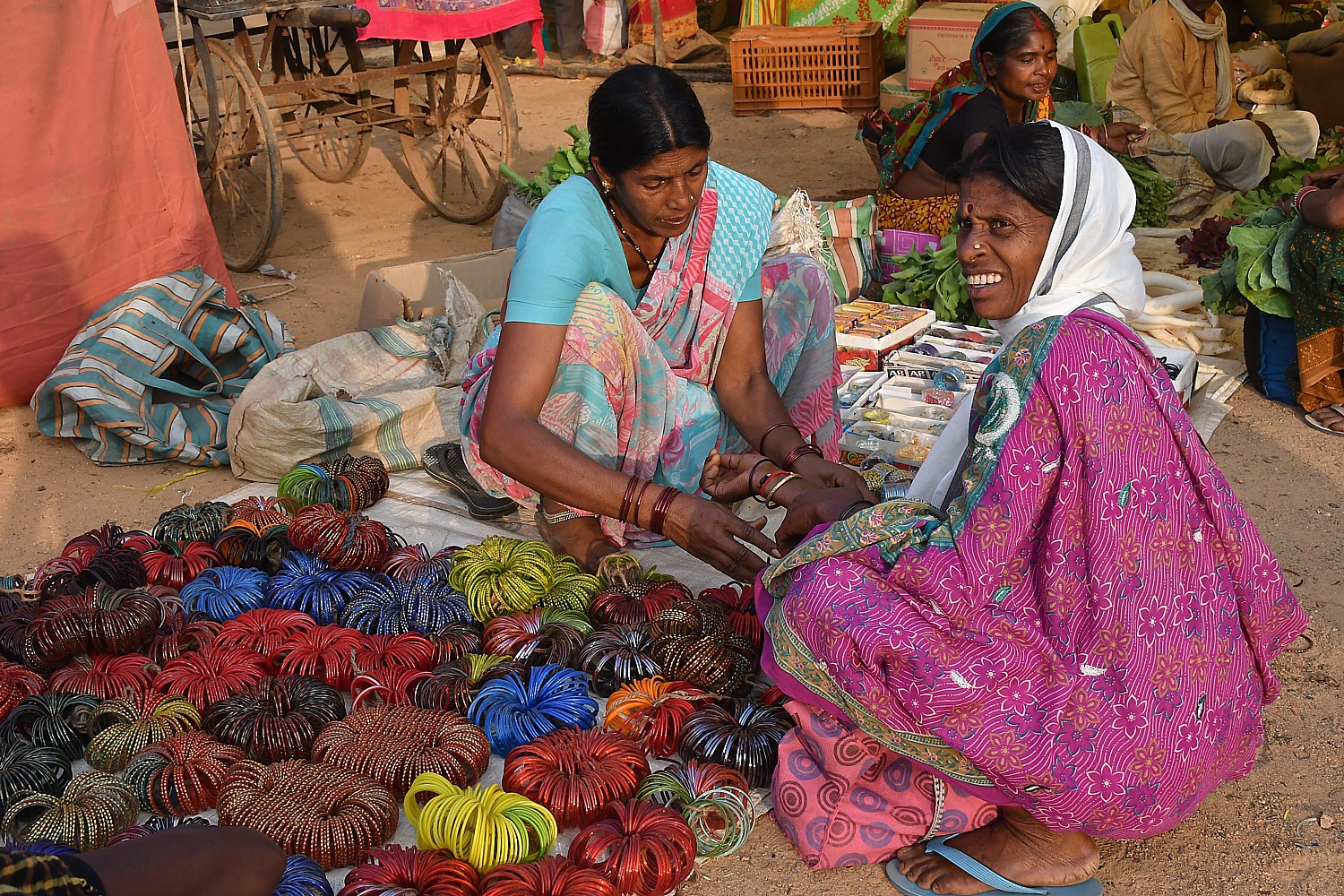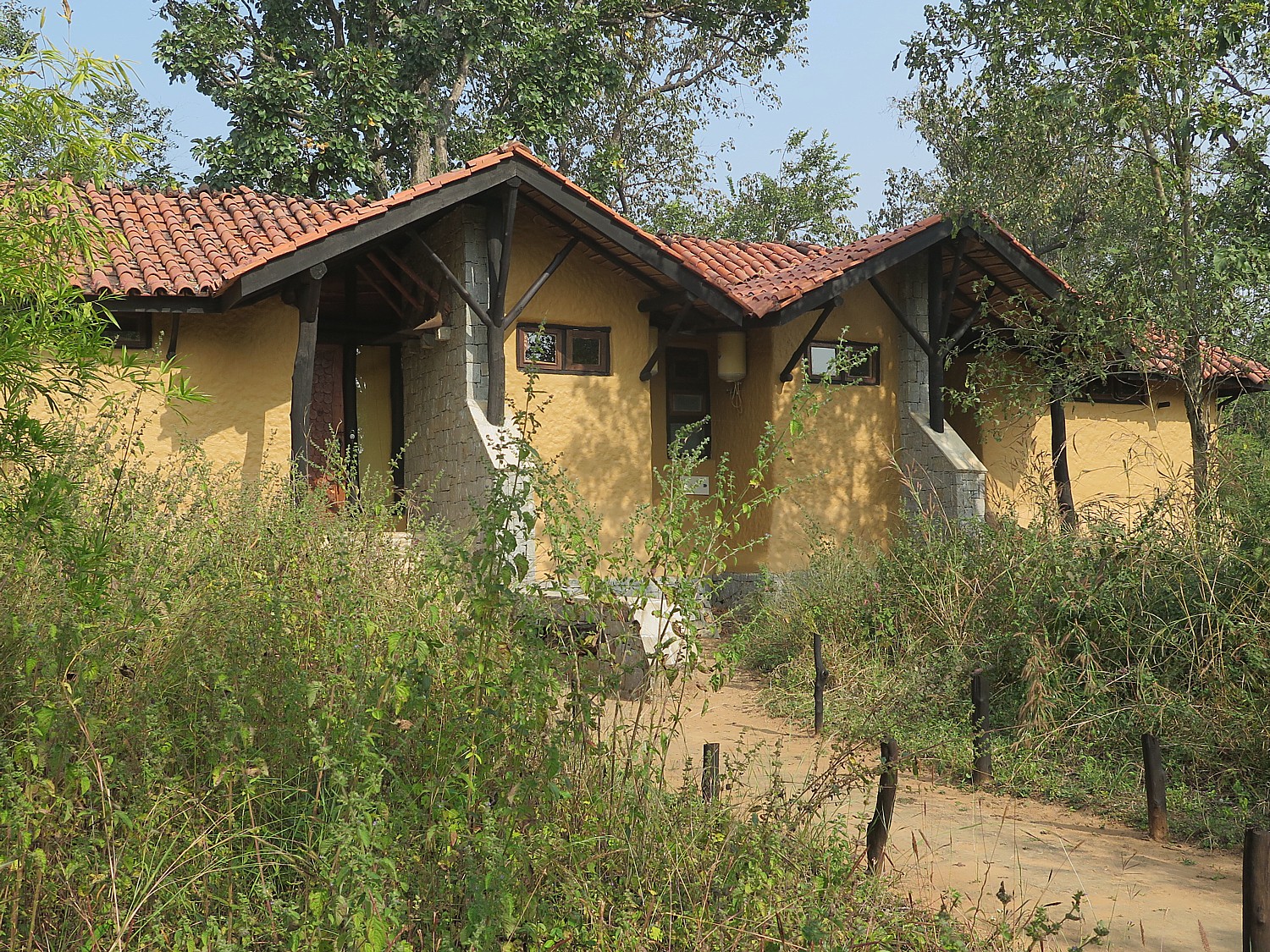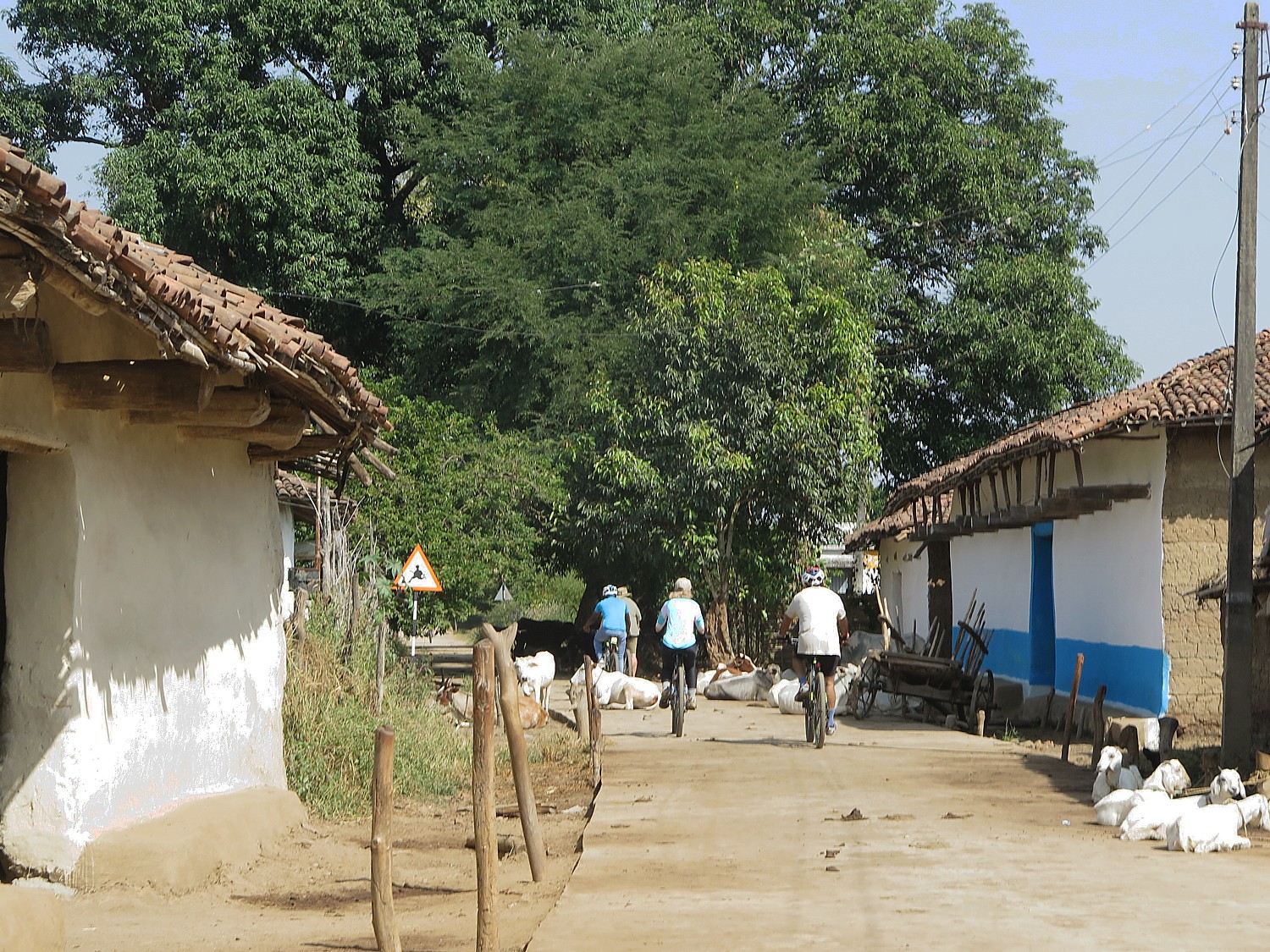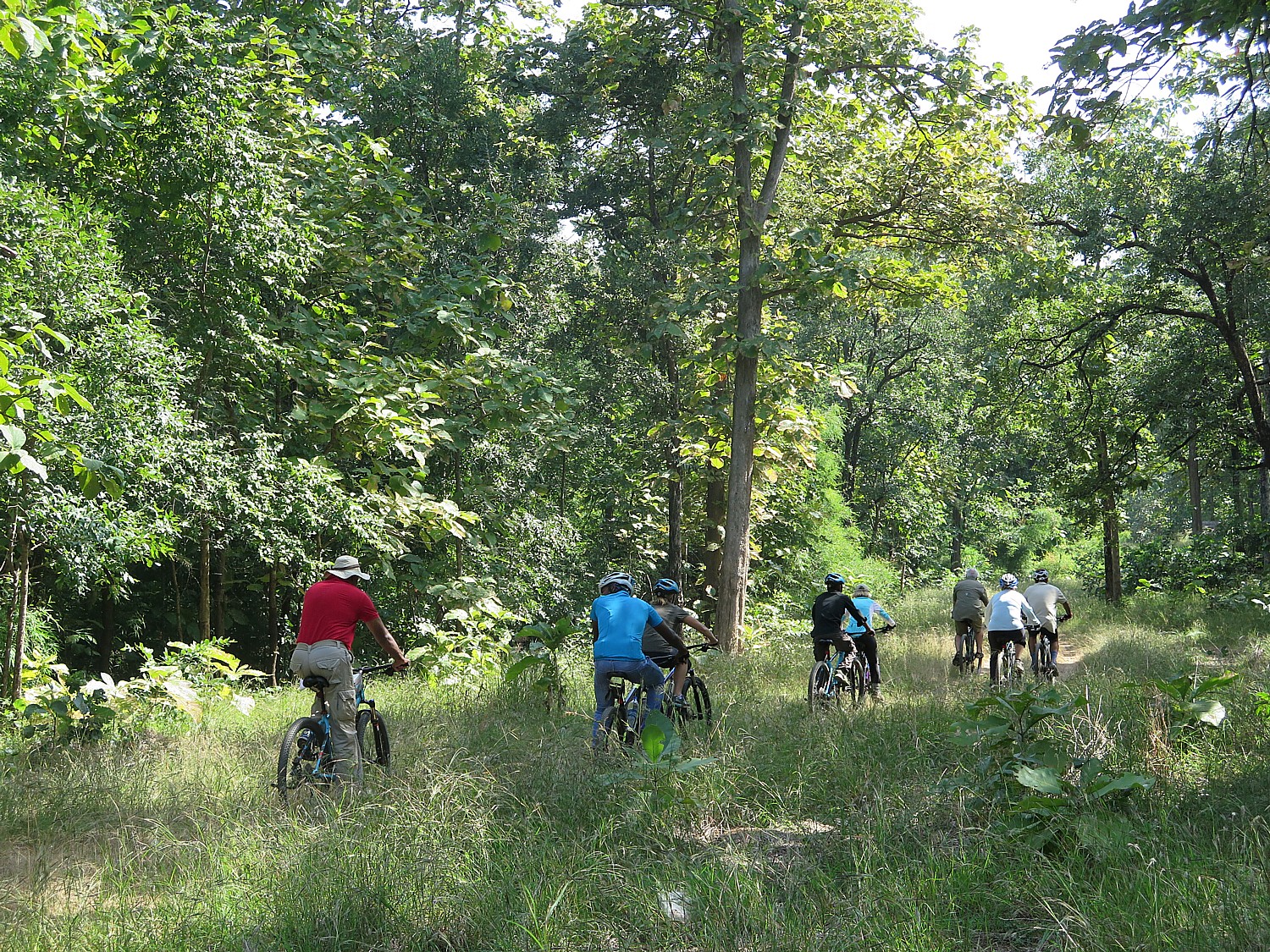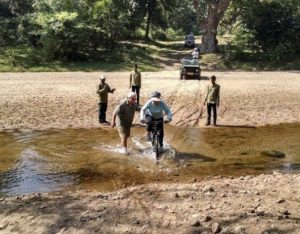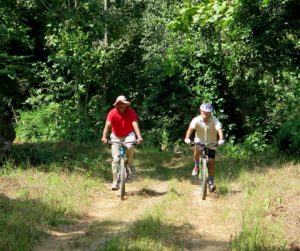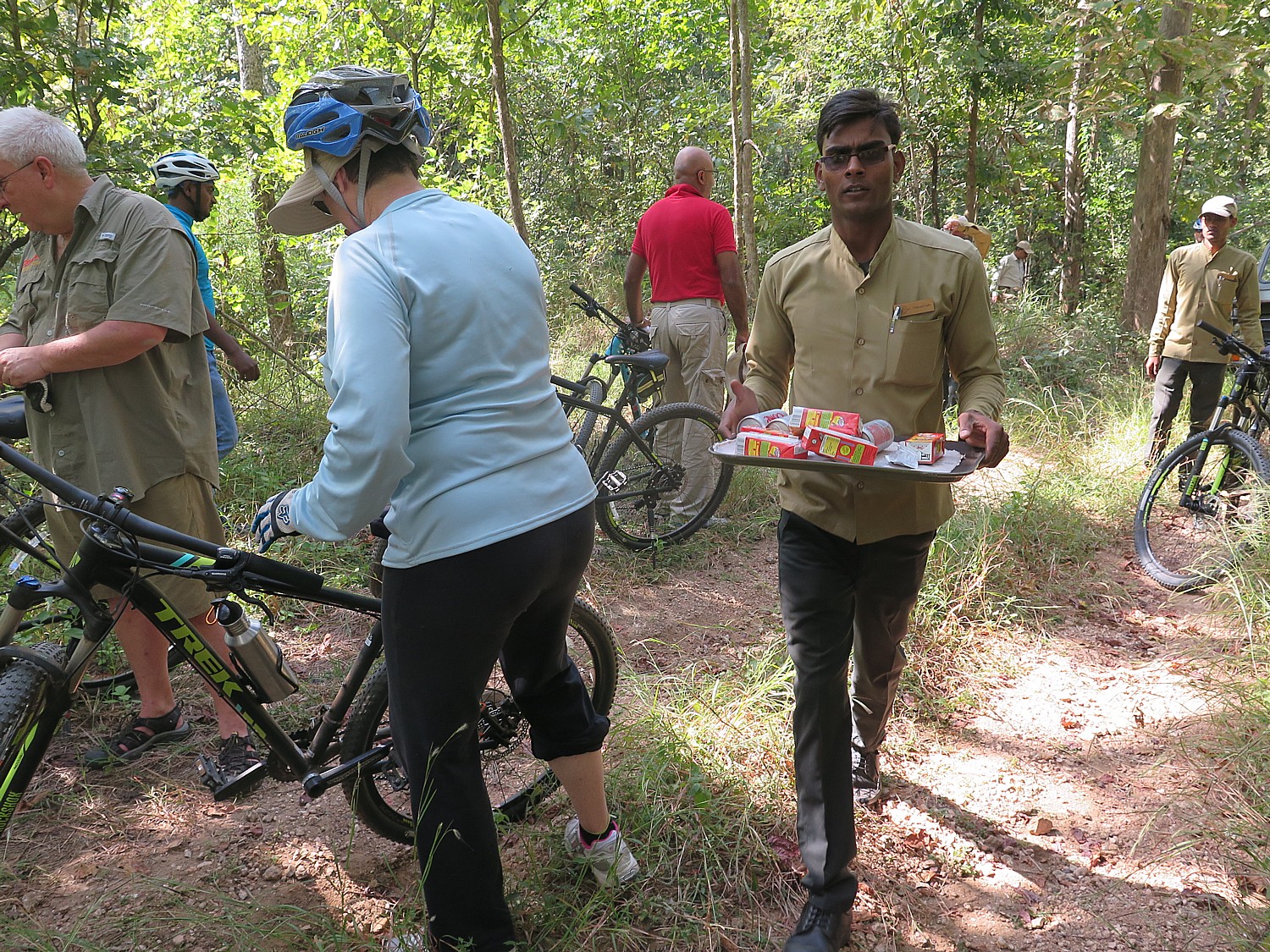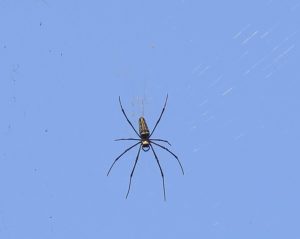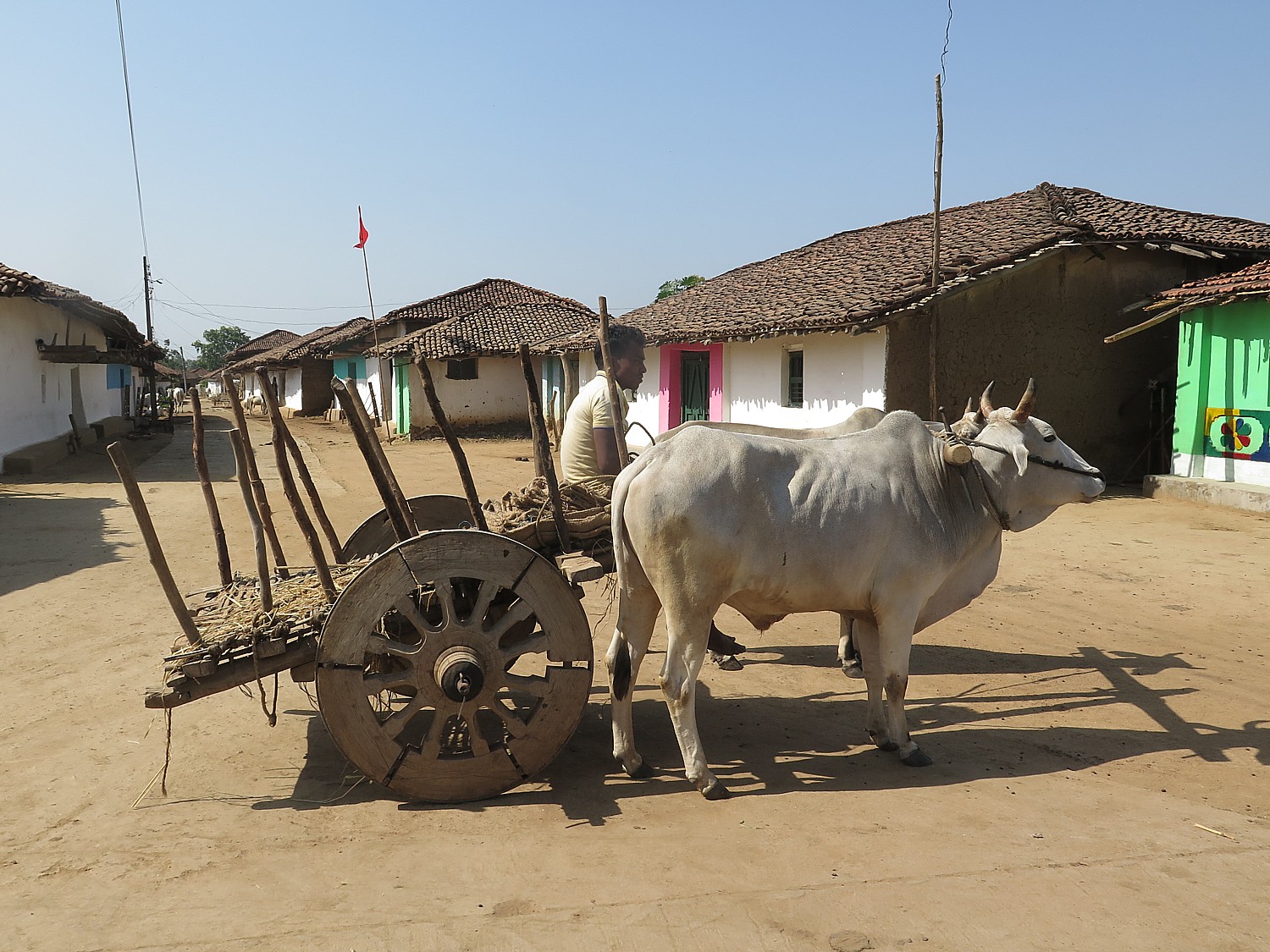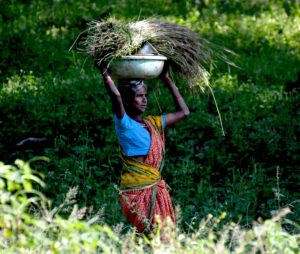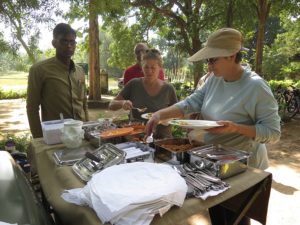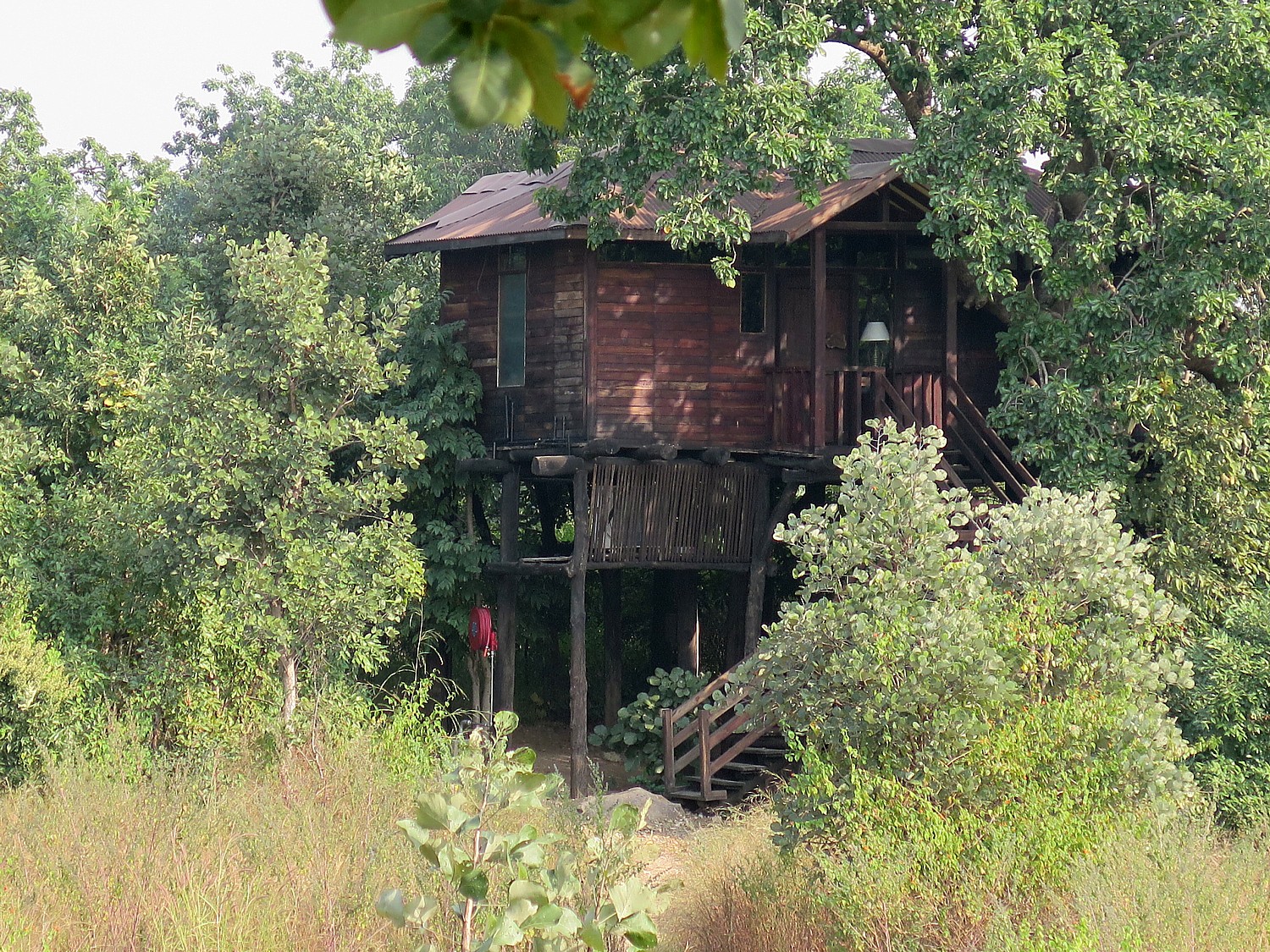
By Karen Rubin, Travel Features Syndicate, goingplacesfarandnear.com
(Our Royal Expeditions ‘Jungle Book Wildlife Safari and Cycling Adventure’ began with our experience cycling through villages and the wildlife sanctuary, itself. See: ‘Jungle Book’ Cycling Adventure Into Tiger Territory of India and ‘Jungle Book’ Cycling Adventure Through Local Villages of India’s Kanha National Park)
Royal Expeditions new “Jungle Book Wildlife Safari and Cycling Adventure” is set in the land of Rudyard Kipling’s fantastic tale of Mowgli, the boy raised by wolves, and his nemesis, Shere Khan, the tiger. During the course of our six days at Pench National Park and Kanha National Park, in central India, we see many of the characters that populated his story and the landscape (“jungle” is the Hindi word for forest) in which they thrived. And much to my amazement, I learn that there may be some truth to the fantastical adventure.
Over the course of our six days – three each at Pench and Kanha – we are scheduled for four game drives, and I soon realize why you need multiple chances if your goal is to spot a tiger: they are really hard to spot.
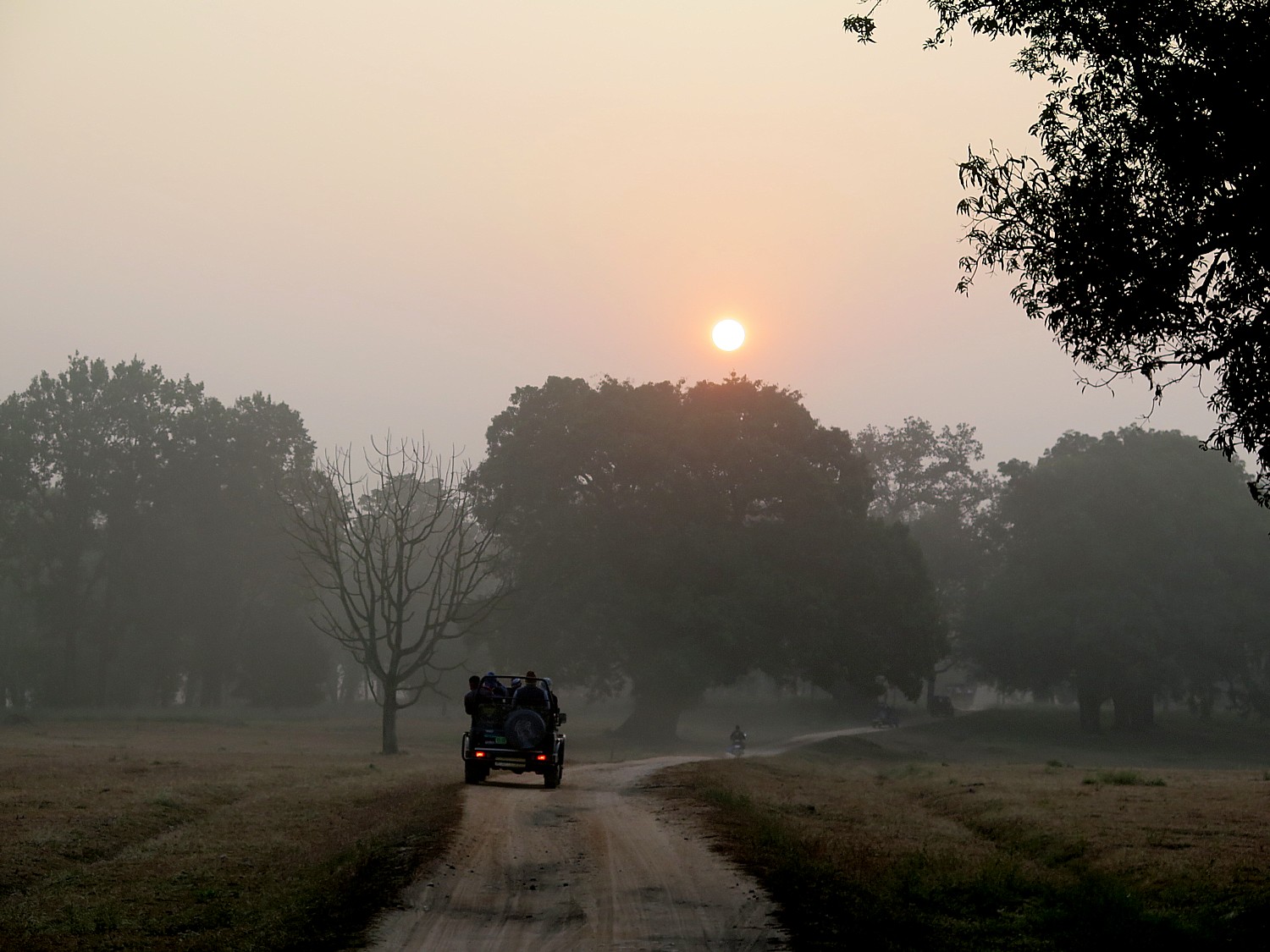
Even without spotting a tiger, each game drive is its own adventure – the landscape of verdant, forest, the serendipitous encounters with animals not even a stone’s throw away, with nothing between you and them. And never knowing what you will encounter and when, or what’s beyond the next bend.
The “hunt” is thrilling: the way the guides track the tigers, looking for tiger tracks in the sandy trail, stopping where the trails cross to listen for “alarms” from the langur monkeys, or the signs of urgency from the herds of spotted deer (their tails go up when they are anxious). When the guides think they hear an alarm, they take off at fast speed, leaving us to bounce around and hold on to avoid being thrown out of the open vehicles.
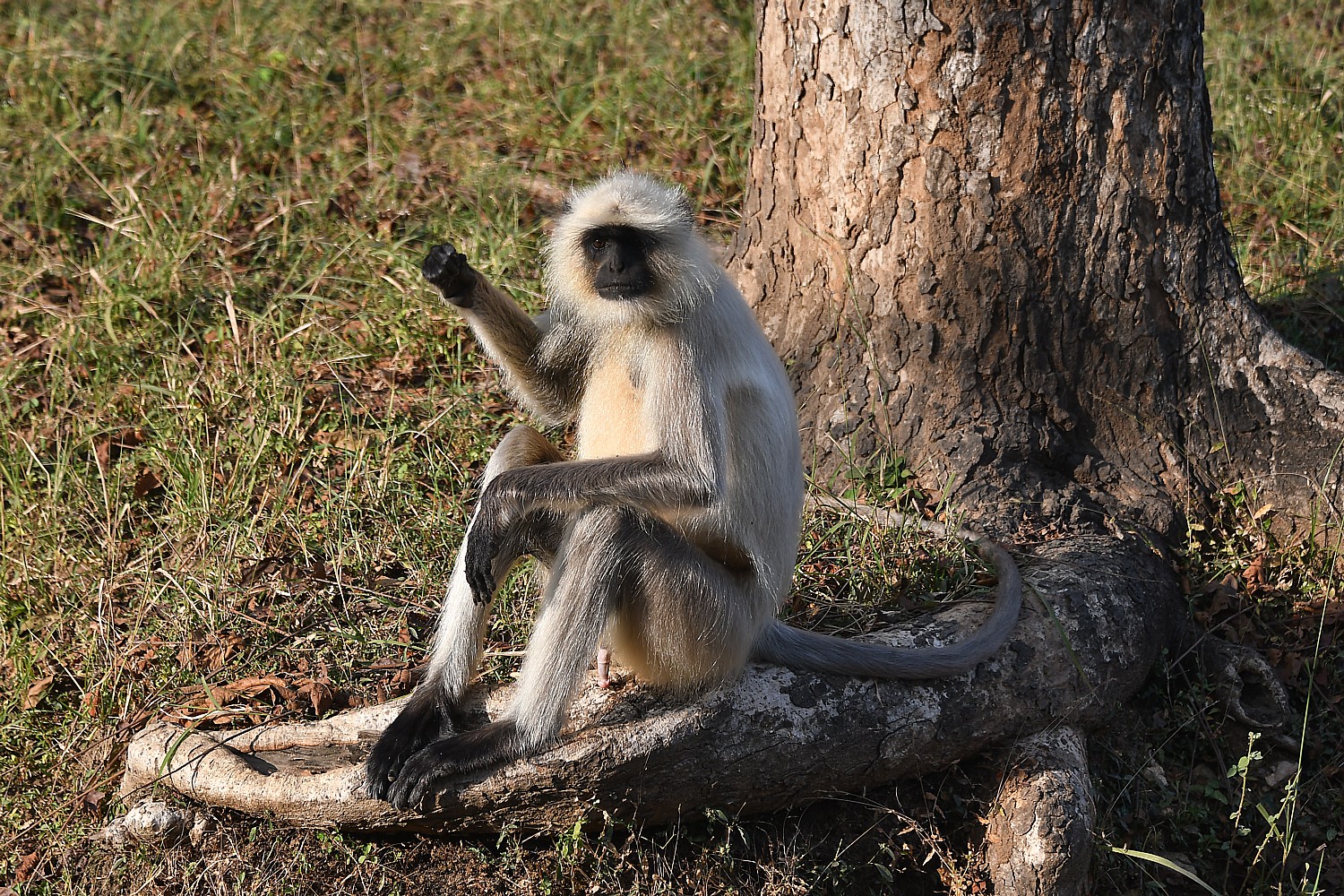
In all my years as a travel writer, this is my first wildlife safari, so the experience is completely new. I am told by my fellow travelers who have much more experience doing safaris in Africa (but never before in India), that there are certain similarities to the structure, the way you experience the animals, largely because of the topography, is very different.
The first thing that is surprising is how early we get up: 4:45 am for a 5:30 am departure, sending us off with hot coffee, tea and biscuits, in order to be lined up at the entrance to the park by the 6 am opening (we will have a full hot breakfast in the park at around 8:30 am, which is an experience itself). It is quite cold – we dress in layers and the Pench Treehouse Lodge gives us blankets (Kanha National Park, at a higher altitude, is actually colder and the Kanha Earth Lodge where we stay next gives us a hot water bottle along with a blanket).
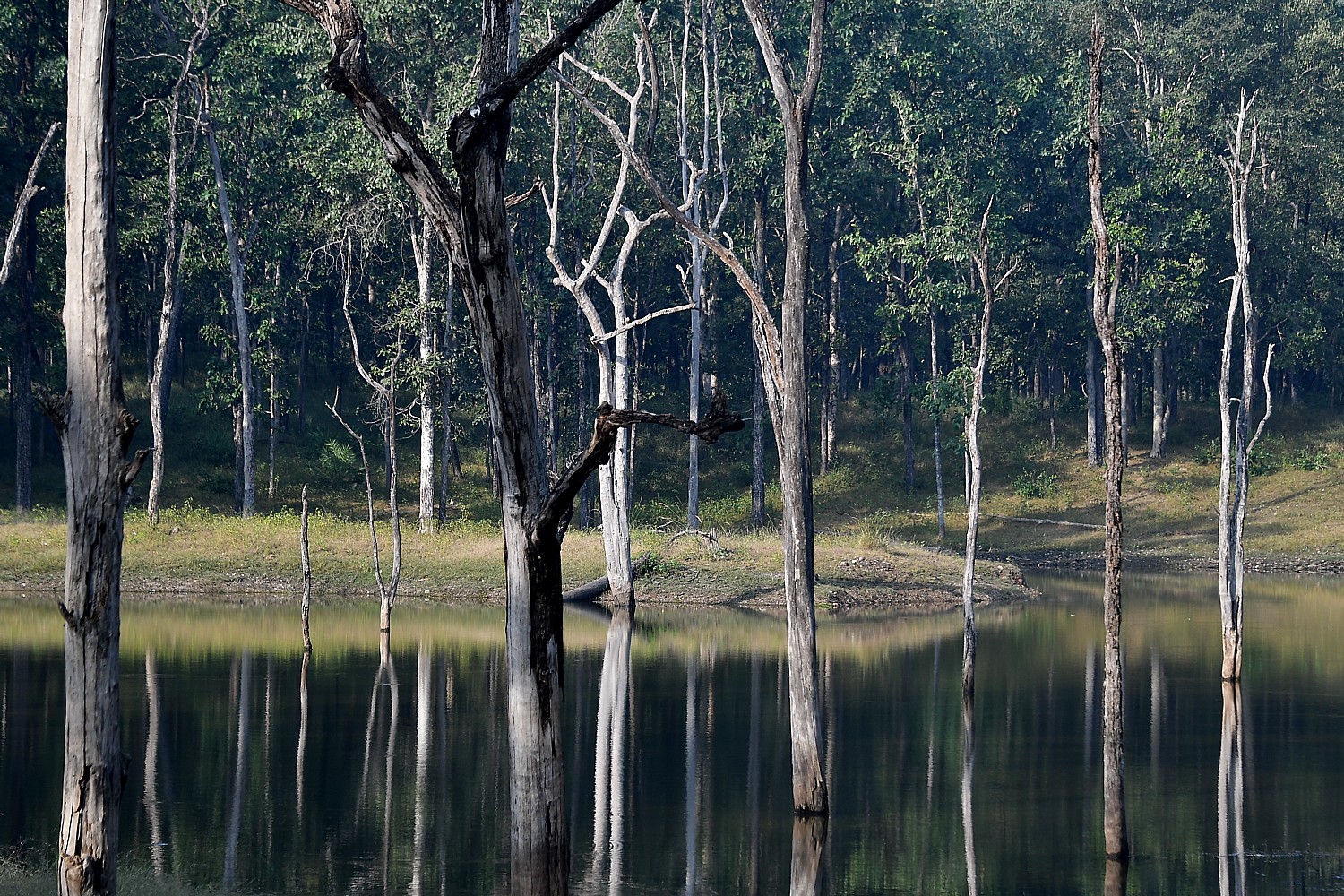
We line up with perhaps 40 other safari vehicles, while our driver (who is also the lodge naturalist) brings our permit (we have to be registered in advance) and shows our passports . We are assigned a park guide and one of four zones where we can explore (only 292 sq km of the 1180 sq km Pench Tiger Reserve is open to the public). Our vehicle comes from the lodge but when additional ones are needed, they hire locals who have their own safari vehicle.
Access to the parks is heavily restricted because they are already overrun with tourists – about 90% of them Indian people versus foreign tourists (and these are mostly British, with a smattering of Europeans and Americans).

As we enter, there is this incredible scene as we watch the orange globe of the sun slowly rising just in front of us and spreading its light through the moisture of the trees.
We are lucky on our first drive – my group gets to spot a leopard on a ridge poking out from bushes (the others in our group, in another vehicle, weren’t so lucky). The leopard is there for a few moments but I manage to get off some shots. Leopards are particularly hard to spot – they are called the “ghost” of the jungle – because they primarily hunt at night.
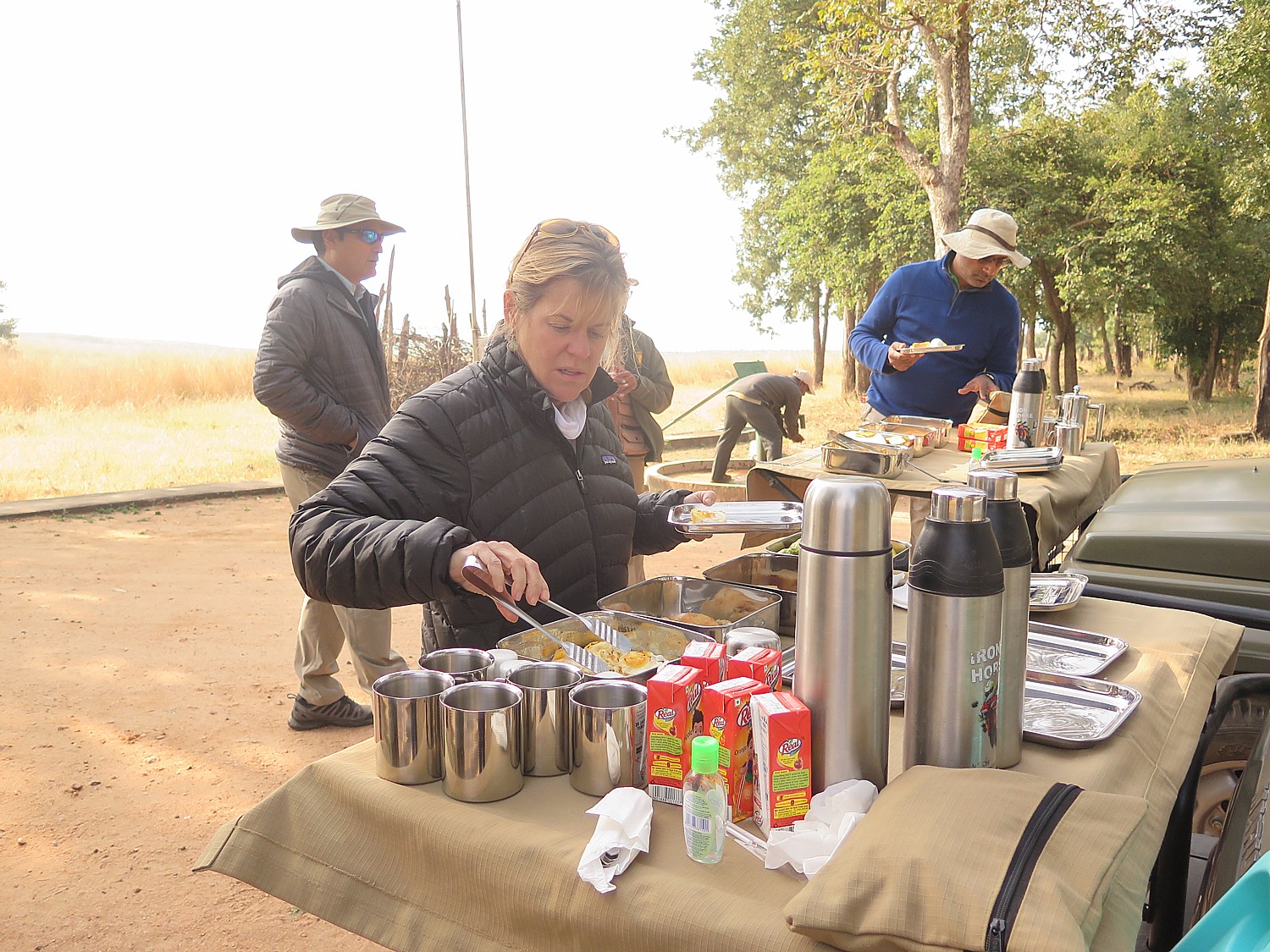
Around 8:30 am, we gather at an appointed place for breakfast – a fantastic meal the lodge has sent along with sunny side-up eggs, pastries, coffee and tea, fresh fruits and juice – which we enjoy in an open area where we see the lake that separates the two national parks, and a vast open area where there is a herd of deer and an assortment of birds. (All the safari vehicles follow the same routine, stopping at around 8:30 am to provide breakfast for their guests.)
Continuing on, we spot a group of jackals – one has a bone in its mouth and makes displays of dominance.
We come to an area with langur monkeys (my favorite jungle inhabitant) – with black faces with defined, expressive features and silvery fur. One sits on a tree root, posing like an old wise man (Jack Benny also comes to mind). Later we find a group of langur monkeys together with a herd of spotted deer.
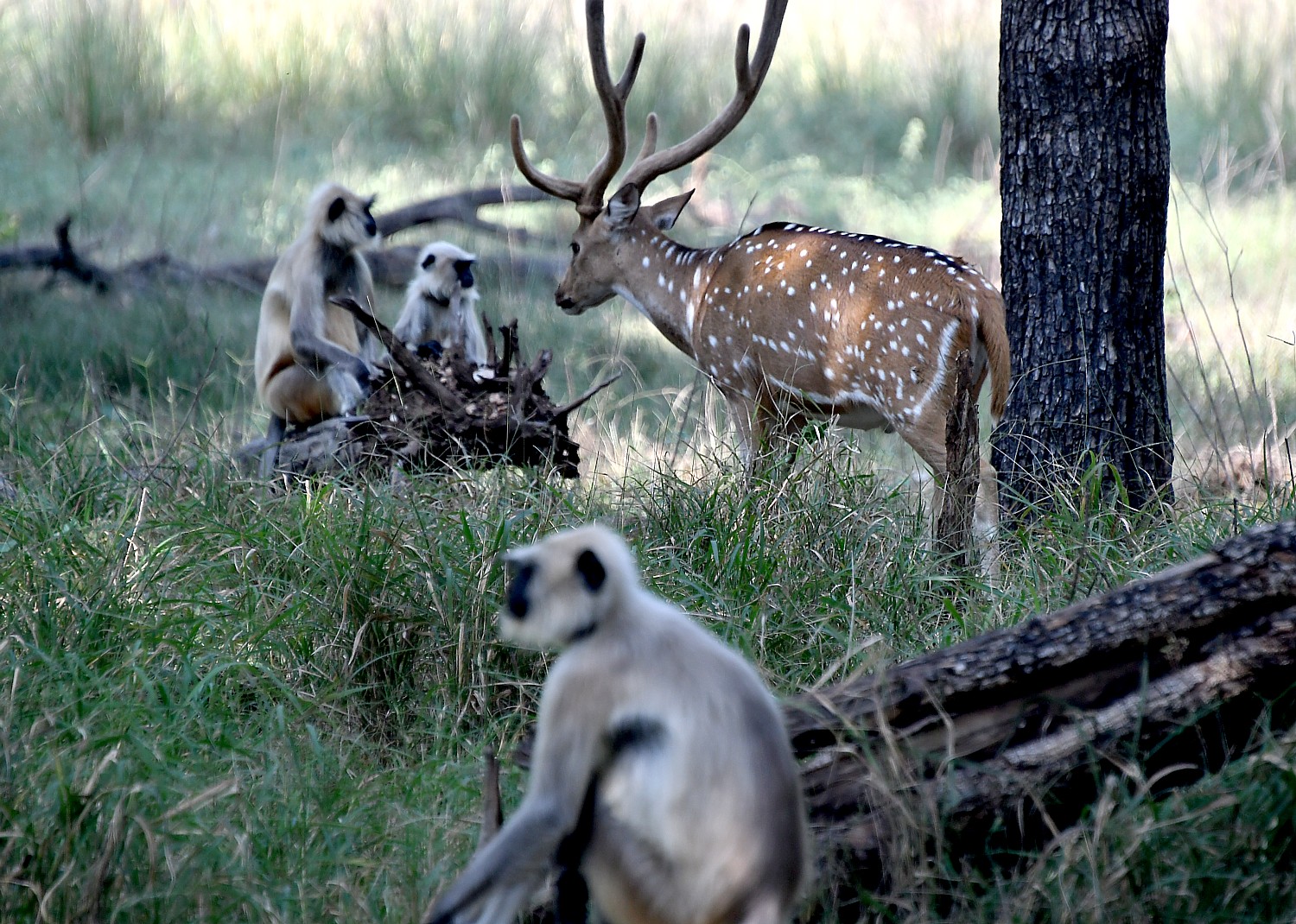
“They are best friends,” Sagor Mahajan, our naturalist from the Pench Treehouse Lodge, tells us. There is a symbiosis between them: the langur sends down leaves and fruit from the trees for the deer to eat and sends off alarms when a predator approaches, while the deer are easier prey than the langur.
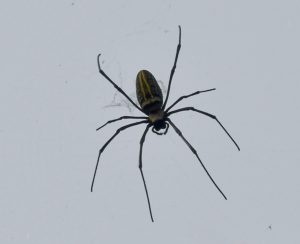
We drive under a massive spider web with a giant wood spider (that’s its name, and for good reason– black and yellow stripes, perhaps 2-3 inches wide. Sagor tells us that the male is tiny by comparison and that the female eats the male after they mate (unless she has something better to eat). For once in my life, I am more fascinated than fearful seeing such a creature so close at hand.
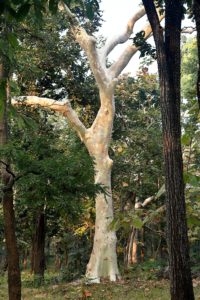
He points out the “ghost tree” – it is starkly white, standing apart from the other trees. This tree changes color with the seasons– white, red, green; it gets its name because especially in the moonlight, it looks like a ghost walking in jungle, its tree limbs looking like arms flailing about wildly; the wood is used to make toys and musical instruments and the gum is used as a laxative and as a thickening agent. “People used to eat the roasted seeds when they were hungry,” he says. He points out the “crocodile tree” – Saga- with bark that resembles a crocodile’s hide. “The tribe here worships the tree; if there is no water, they harvest water from the Saga tree.”
We come upon a pack of wild dogs – actually a rare sight – devouring a deer carcass. It is amazing to watch their teamwork: a couple stand like sentries, facing out, while the others tear at the carcass, switching off. Watching the dogs, I wonder why we don’t see more bones around – I learn that the bones are degraded by bacteria and fungus, taking about a year before they are reduced to nothing.
There are 60,000 spotted deer in Pench – the largest concentration in India – in fact, too many, we are told. But they provide the food source for the tigers, leopards and other predators.
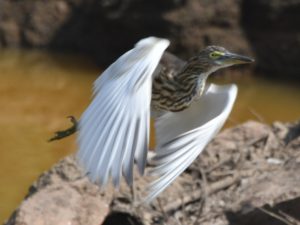
The profusion of birds is unbelievable: in the course of our visit, we see most of the “star attractions”: the Greater Racket-tailed Drongo (my favorite, a blue-black bird with two hanging tails); the White-rumped Shama, the Gold-fronted leafbird, the Indian Roller, the streak-throated woodpecker, the Changeable Hawk-Eagle, the Coucal (big bird, brown and green, red eye), peacocks (they sleep in trees at night; the male loses its feathers during monsoon, then grows new ones), the white-eyed buzzard, the Indian Pond Heron (also called “magic bird” , it looks white when it flies); green parakeet; Crested serpent eagle (feeds on snakes); the Rufus tree pie (known as a tiger bird because has the same colors); and the Red Jungle fowl (the first chicken in the world) and the Crested serpent eagle (feeds on snakes).
Sagor says he has personally spotted over 100 species in Pench; there are over 200 in the region.
It is amazing to me what an eye Sagor, our guide, has – he spots two tiny Indian Scops owls the exact color of the knot-hole in a tree, and stops the vehicle. We can barely see it.
He tells us that Pench, which is named after a nearby river and was designated a wildlife sanctuary in 1983, has about 43 tigers. That they are methodical (something that helps poachers): they are out until about 8:30 am, then sleep until evening in the winter. They only live about 13-14 years.

Only 292 sq km of the 1180 sq km Pench Tiger Reserve is open to the public as Pench National Park, on the border of Madhya Pradesh and Maharashtra states, where a number of endangered species are protected. The tiger is the dominant predator here, The other predators include leopard, dhol (Indian Wild Dog), wolf, hyena, jackal and jungle cat. The prey species include chital (spotted deer), sambar deer, muntjac, gaur, wild boar, langur monkey and rhesus macaques. There is a rich birdlife with over 300 recorded bird species, including parakeets, hornbills, kingfisher, barbets, minivets, orioles, wagtails, and a host of raptors; the crested serpent eagle, crested hawk eagle and white-eyed buzzard. (Amazingly, we see most of these during our visit).
The Real Jungle Book
On the way into Pench National Park for our morning game drive, as we pass villages, Sagor Mahajan, the naturalist from the Pench Tree Lodge, tells us that though this is land is the setting for Kipling’s Jungle Book, Kipling never actually visited here –it was his father who spent time here and inspired his son with his stories. But then Sagor shocks me by saying that the story could have had a basis in fact, of an actual boy brought up by wolves.
“There are two stories about Kipling: in the first story, Rudyard Kipling’s father visited often, loved it, and would narrate stories to Rudyard – that’s how young Rudyard Kipling was inspired, but never visited,” he tells us as we rumble along the road.
“In the second story: two British guys roaming around a nearby village learned of a story about a young boy who was rescued, who had been brought up by wolf pack. He couldn’t speak human, walk like a human, nothing about him was like a human. The boy was actually found and rescued, but he died two or three years after. Both of them wrote separate books about it.” Kipling, he says, likely read the stories.
This is utterly fascinating – but surely, such a fantastical legend must be part of that village’s folklore, passed down from generation to generation?
I’m intrigued enough to do my own research, finding an article in the Times of India by a reporter who did trace the original stories and visited the village.
In his article, “Did Seoni have a Real Mowli?,” Sumeet Keswani writes:
While Kipling’s was a work of fiction, it’s said to have been inspired by Sir William Henry Sleeman’s pamphlet, An Account of Wolves Nurturing Children in Their Dens, which describes a wolf-boy captured near Seoni in 1831. Sleeman was a British soldier and administrator and is known for his work in suppressing thuggery. We found a mention of the wolf-boy named ‘Seeall’ in Mervyn Smith’s Sport and Adventure in the Indian Jungle, which describes his capture and behaviour in captivity. “I have reason to believe that he was the original of Rudyard Kipling’s Mowgli,” the author writes.
Mowgli is still a “pervasive theme” in the district – there are caricatures on bus stands, an annual Mowgli Mahotsav, Keswani finds, but is not, apparently, a folk story that is widely shared.
“The only clue is talk about a cave on the outskirts of Kanhiwada, a village that finds mention in the original tale,” Keswani reports. But in his investigation, he could not find any local people to give credence to it.
“In the book, Mowgli may have been the target of Shere Khan, but today the tigers of Pench are the ones in danger,” he writes.
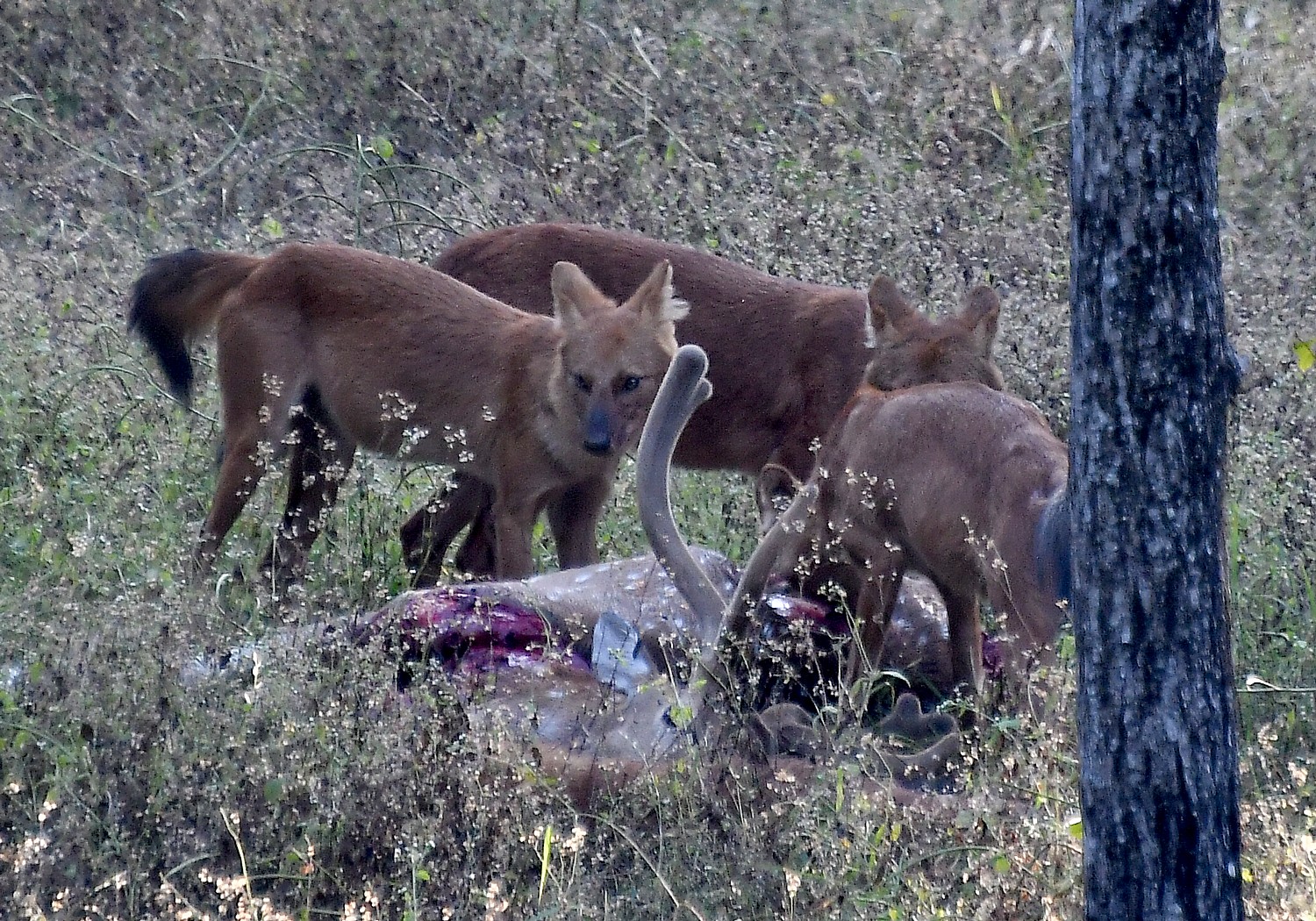
While we don’t actually see any wolves, we do get to see a pack of wild dogs tearing apart the carcass of a deer, and over the course of our visits into the parks, see many of the animals that animated the Jungle Book characters. But after our three game drives in Pench, we have yet to see the tiger. But we still have our visit to Kanha National Park, where we go next.
Pench Tree Lodge
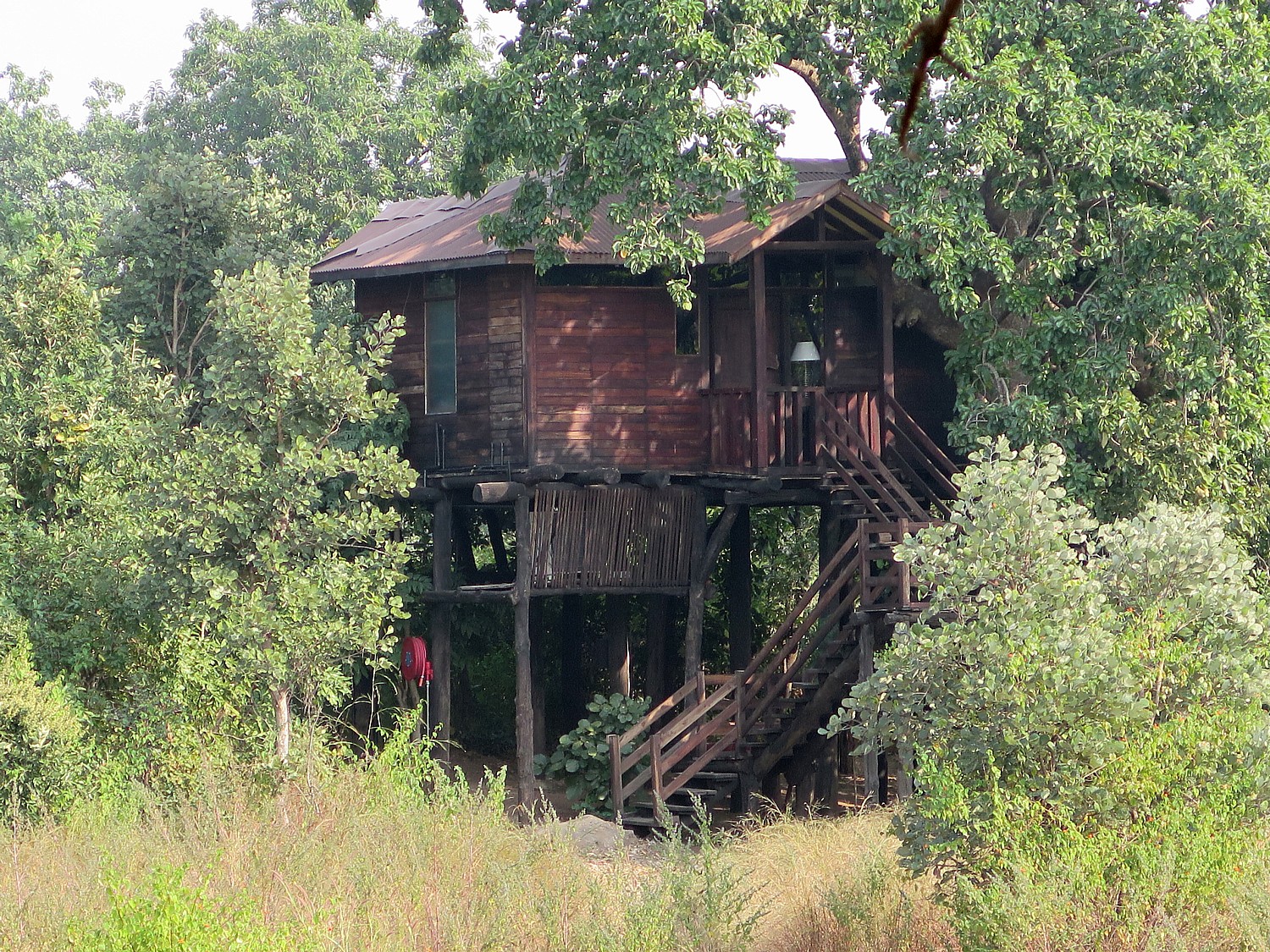
What makes the experience all the more special are the accommodations: Pench Tree Lodge (www.PenchTreeLodge) which only opened in 2016, is literally a tree house, built of all natural materials, but with stunning design, local and traditional art, and every comfort and amenity you could crave. There are just six of these tree house accommodations spread over 16 acres.

There is a gorgeous dining lodge and the restaurant is headed by sensational chef, Chef Pankaj Fulera who was runner-up for Best India Chef) who is equally adept at traditional Indian cuisine as a fusion Continental (cooking classes and a tour of the kitchen can be arranged). Every dish is served with stunning presentation. The dining lodge has two different dining rooms, plus a lounge area.
One night, our dinner is served outside, under a tree that I have taken to think of as The Tree of Life. The atmosphere is breathtaking. We are there just as they are replanting the lodge’s organic garden, which supplies the kitchen.
Our tree houses have a balcony (mine has an enormous Mahua tree, the dropped leaves of which are turned into a liquor), and a stunning bathroom.
They both are absolutely perfect- luxurious, comfortable, sophisticated and gorgeously designed, but designed to blend perfectly with the environment, and support the local tribal people. They enhance the experience.
There is also a fantastic lap-size swimming pool (so much fun to swim and watch the green parakeets flying above).
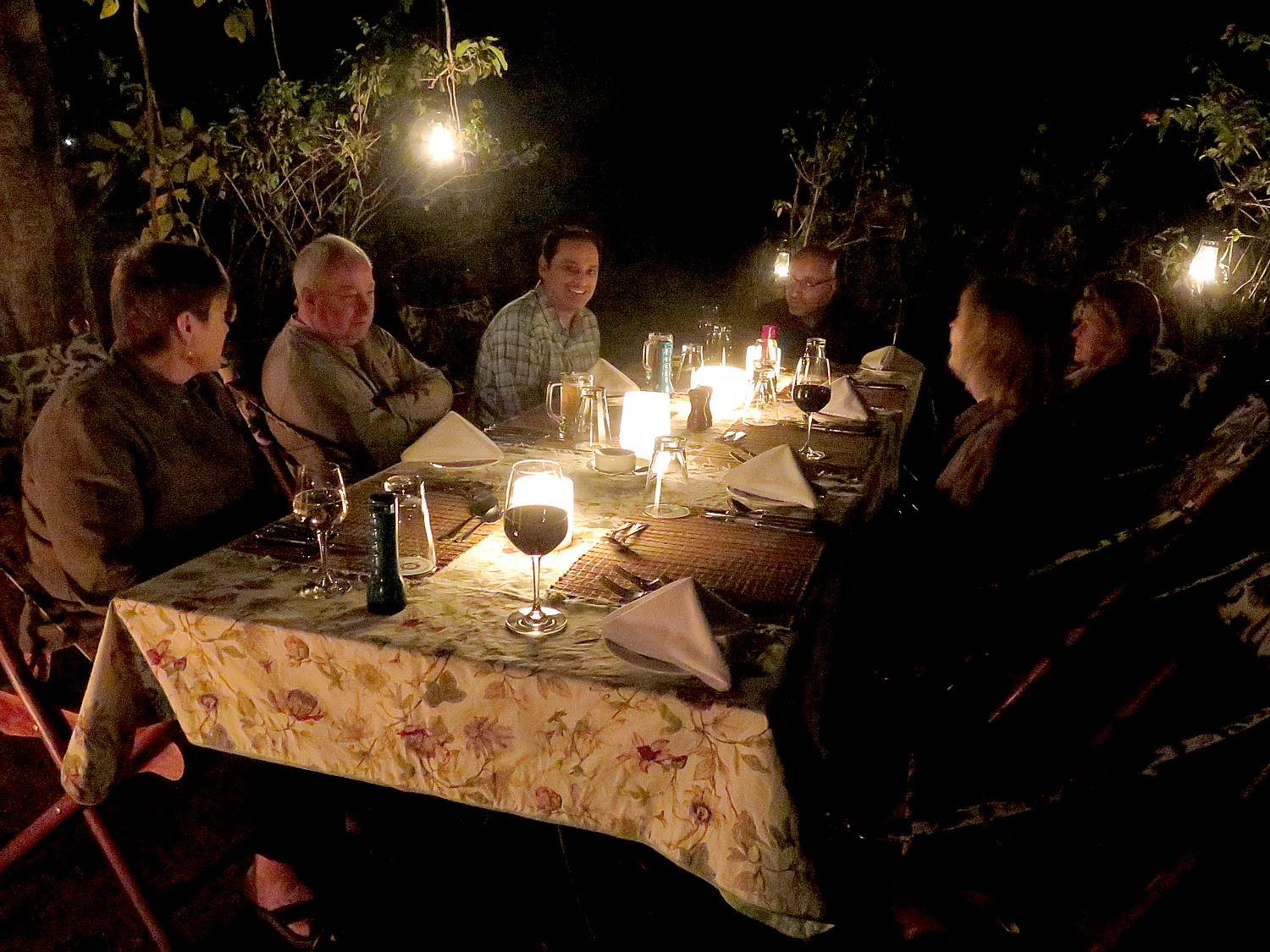
Pench Tree Lodge offers impeccable service, which you note immediately with the staff on hand as our van pulls up, with moist towels and a refreshing beverage – cold when it is hot in the afternoon and hot when it is cold at night. You really get some of that vibe as if we were a royal hunting party (okay, we are out for photos, not trophies).
Our rooms are supplied with coffee, tea and bottled water (flashlights, too). When we leave for our game drives at around 5:15 am, they have coffee and tea and biscuits on hand, blankets in the jeeps.
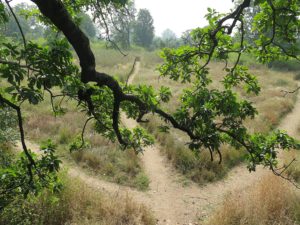
At the Pench Tree Lodge, between dusk and dawn, we must call for someone to escort us to and from our tree house (the lodge is, after all, contiguous with the national park, and I think it also has to do with snakes) and each tree house has a device that emits a high-pitched sound that can’t be heard by humans, that deters rodents from entering. We are warned that at night we might hear the sound of monkeys jumping on the roof and when that happens, I am grateful for the warning.
The dining lodge has two different dining rooms, plus a lounge area. (Cooking classes can be arranged).
One of the reasons Pench National Park is so popular with tourists is that it is the closest tiger park to a well-connected commercial airport in India -Nagpur is about 3 hours drive. Karmajhiri gate (where we stay at the Pench Tree Lodge) and Jamtara entrance gate of Park are at the furthest points, so get fewer visitors. More significantly, you really feel immersed in local life.
Apart from the wildlife, the Royal Expeditions “Jungle Book” tour also provides distinctive opportunity to experience rural life in India – the “soul of India” is in its villages, where 60% of the 1.2 billion people still live -and meet with local people who live in harmony with wildlife. Just how much in harmony? We see thatched, raised platform shelters so that the farmers sleep in their fields at night to guard against encroaching animals.
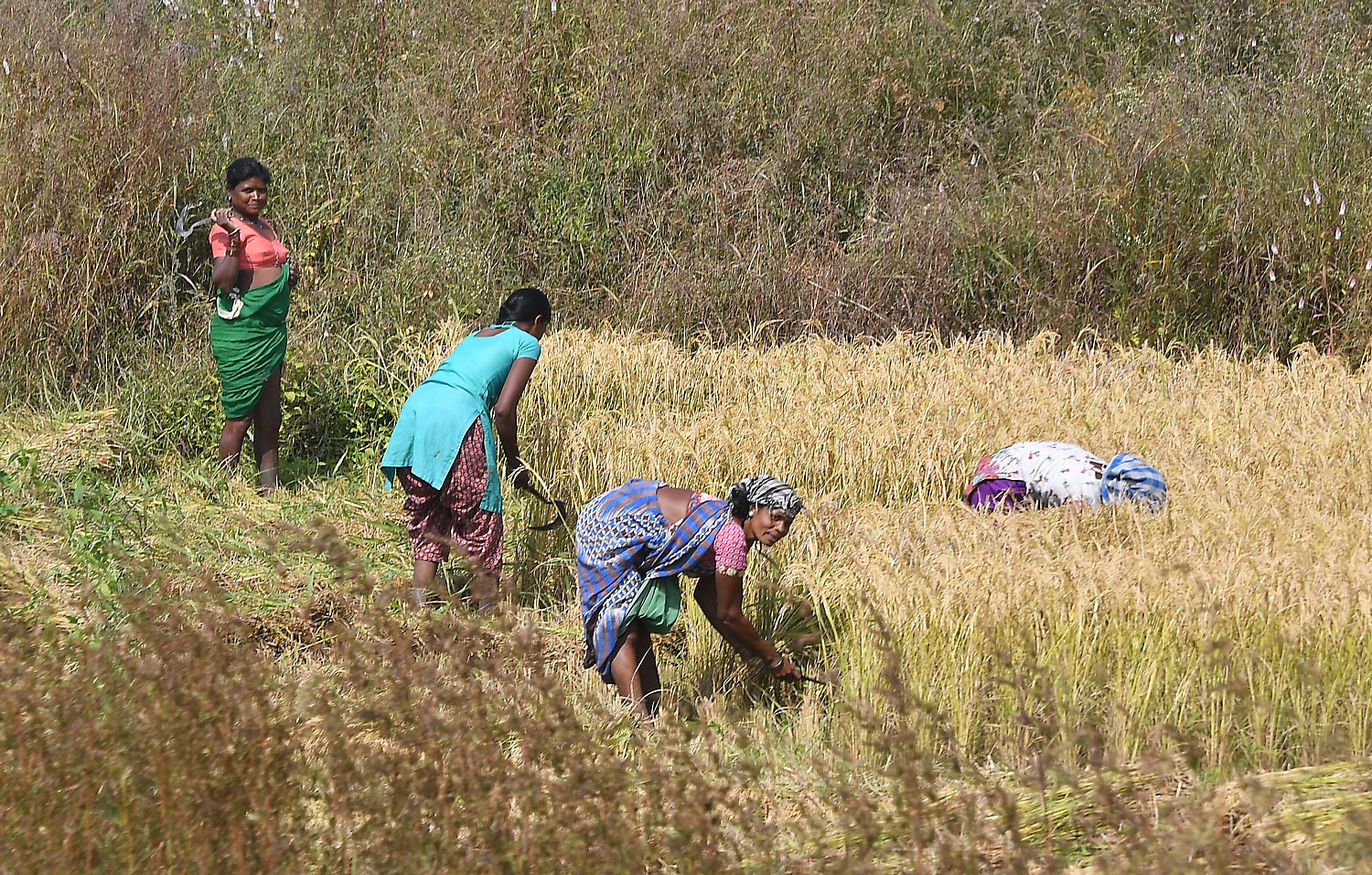
On our way back from our game drive in Pench, looking out over the fields being tended by farmers, Sagor Mahajan, our naturalist from the Pench Treehouse Lodge, tells us that the villagers here have lived here for generations – they are descended from people who migrated from South Africa in the 17th century.
I’m thinking how interesting that is, because of his description of the dragonflies we see, Wandering Gliders, which, he says, migrate back to South Africa, taking four or five generations to complete the trek, the longest migration of any insect.
For more information, contact Royal Expeditions Pvt. Ltd. www.royalexpeditions.com, tours@royalexpeditions.com, or Royal Expeditions’ North American representative: kiki@wanderlustportfolio.com, 720-328-8595.
Next: Tiger, Tiger! On Safari in India’s Kanha National Park
See also:
‘Jungle Book’ Cycling Adventure Into Tiger Territory of India
‘Jungle Book’ Cycling Adventure Through Local Villages of India’s Kanha National Park
____________________
© 2017 Travel Features Syndicate, a division of Workstyles, Inc. All rights reserved. Visit goingplacesfarandnear.com and travelwritersmagazine.com/TravelFeaturesSyndicate/. Blogging at goingplacesnearandfar.wordpress.com and moralcompasstravel.info. Send comments or questions to FamTravLtr@aol.com. Tweet @TravelFeatures. ‘Like’ us at facebook.com/NewsPhotoFeatures

